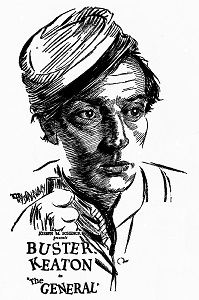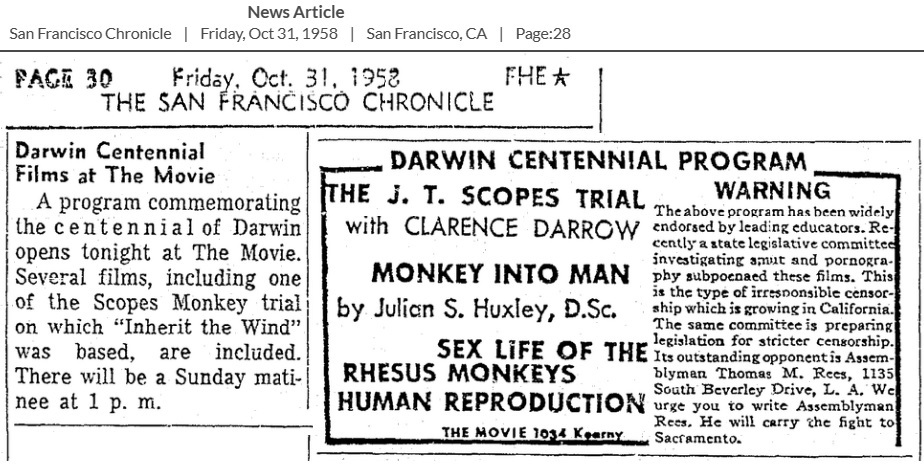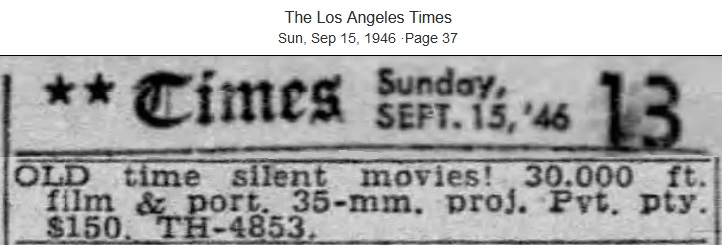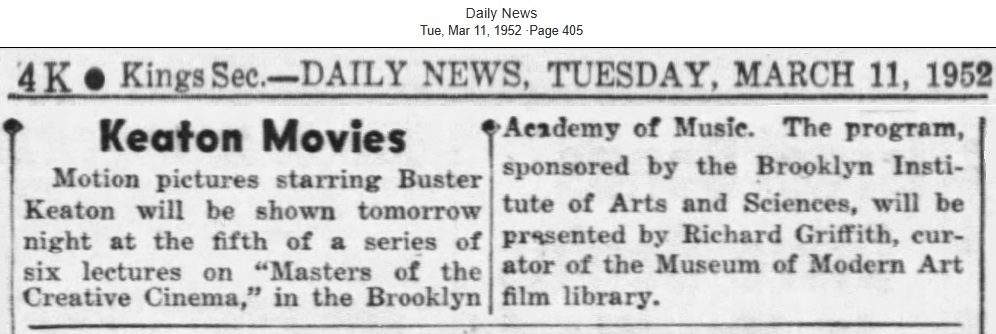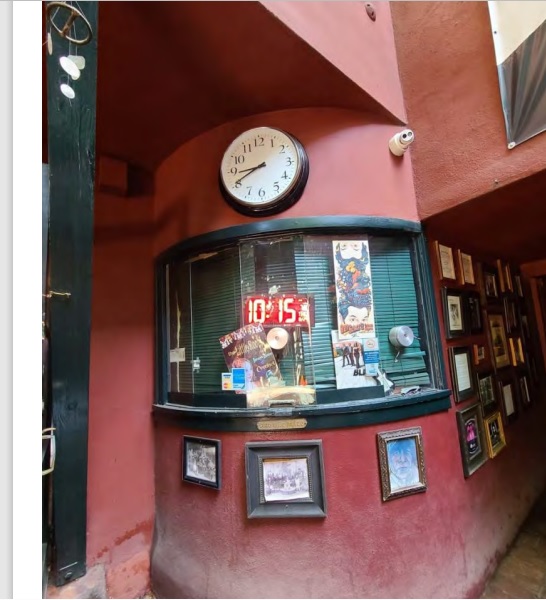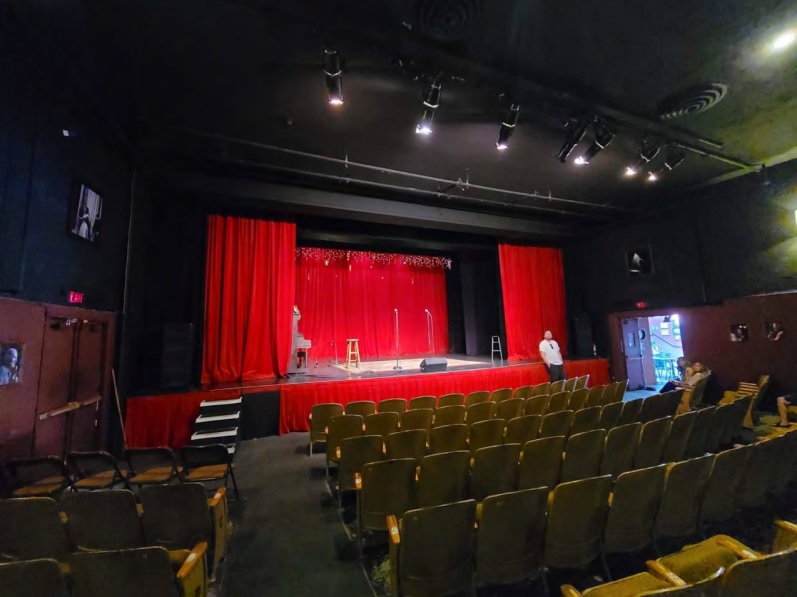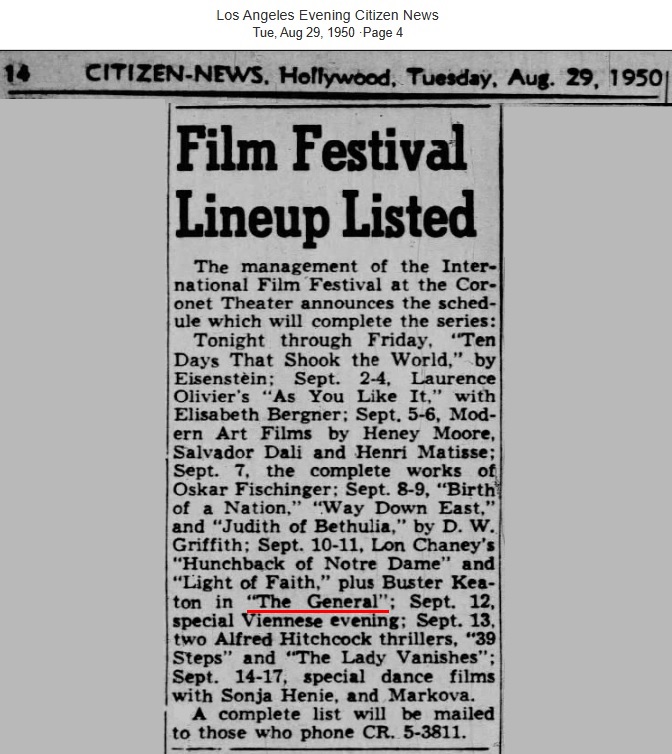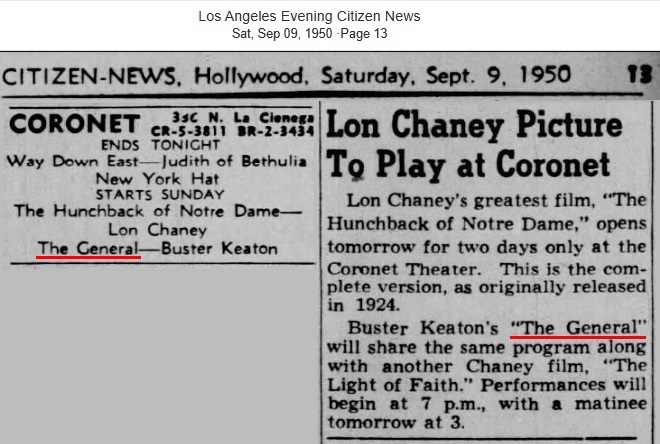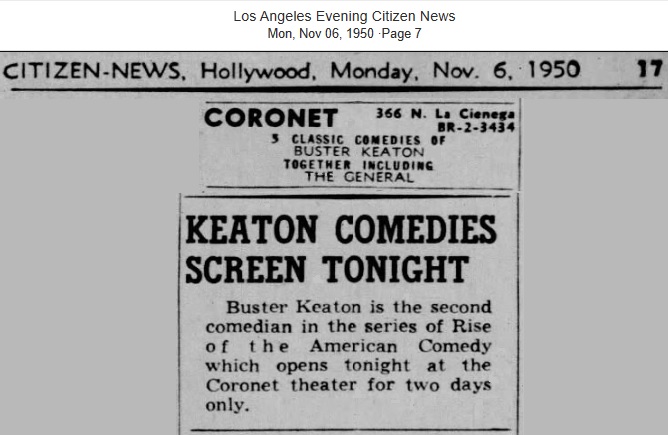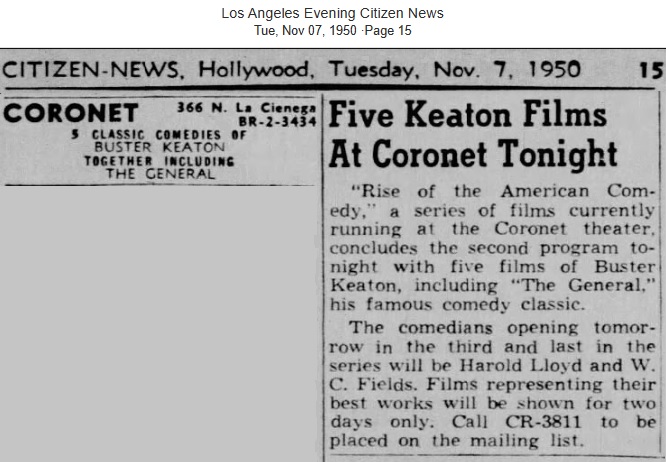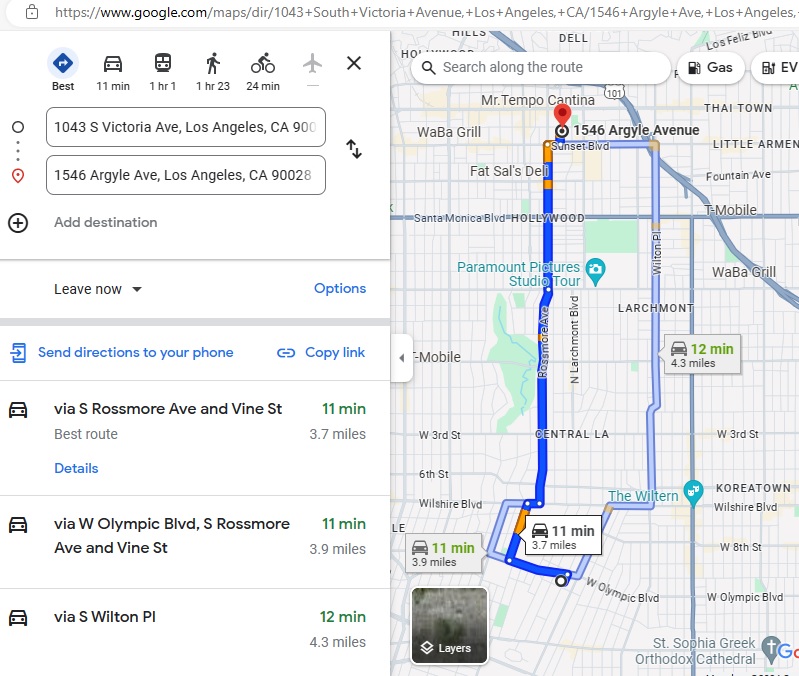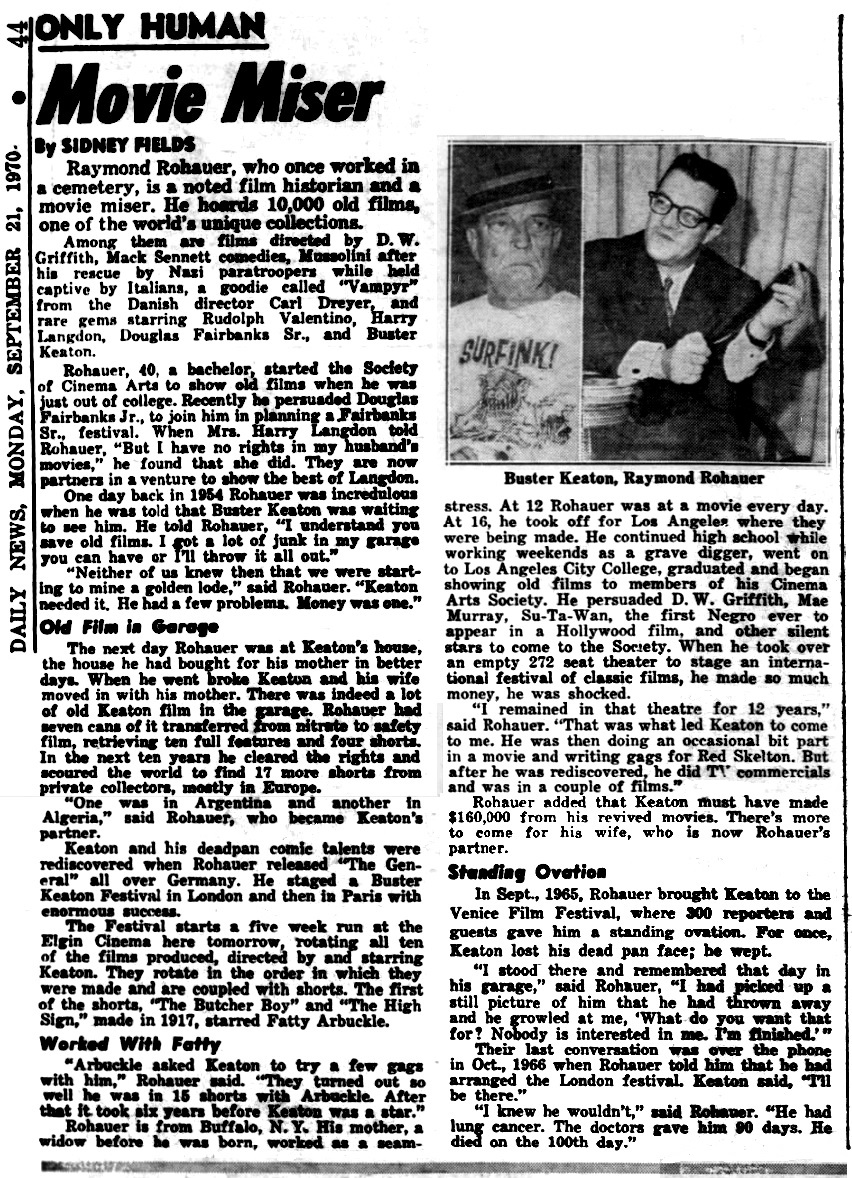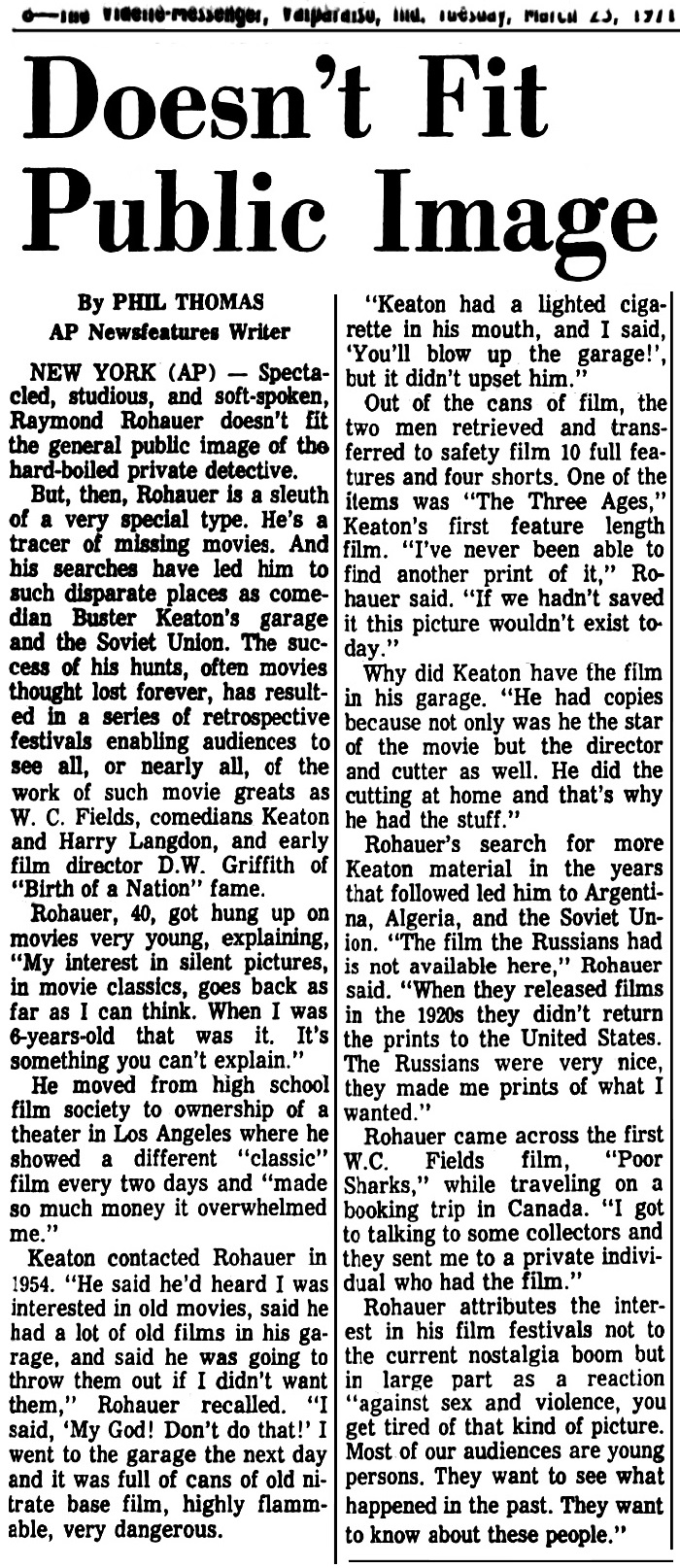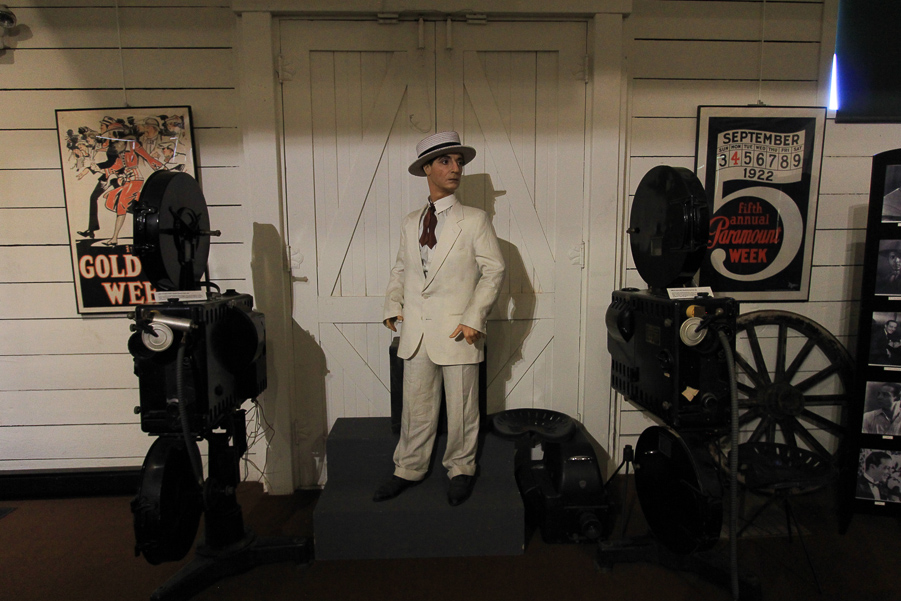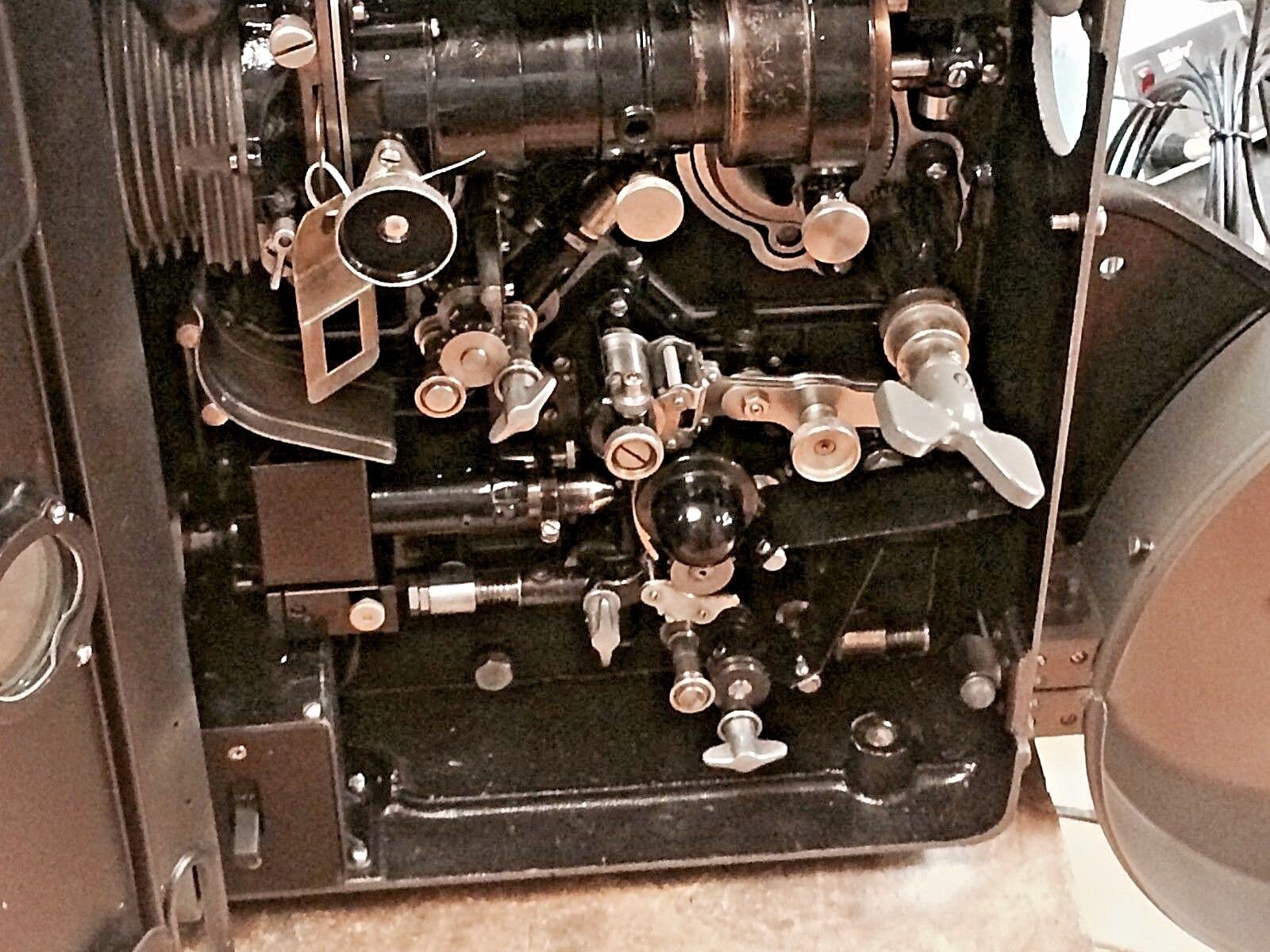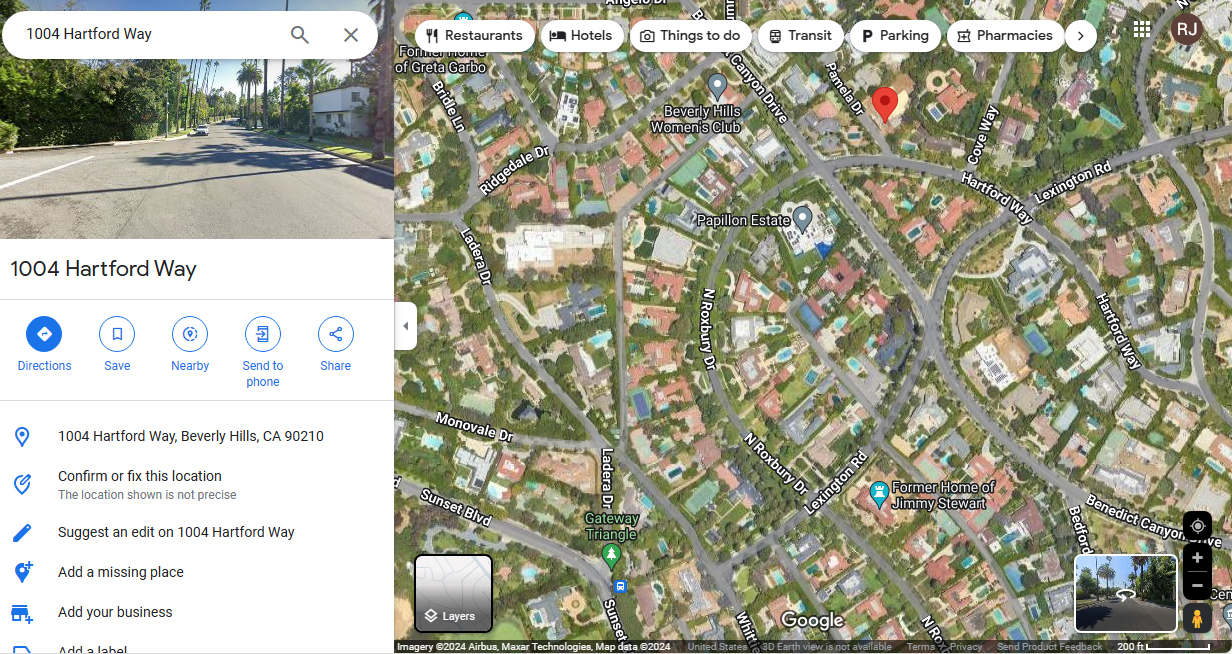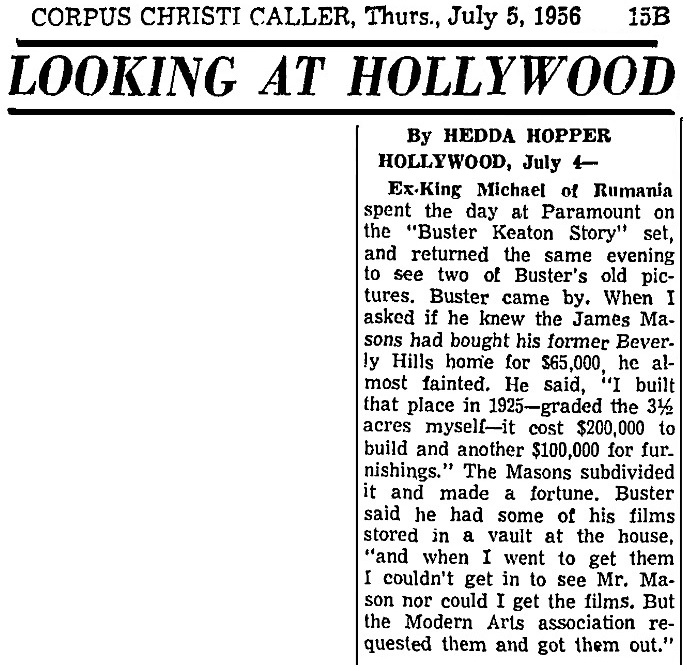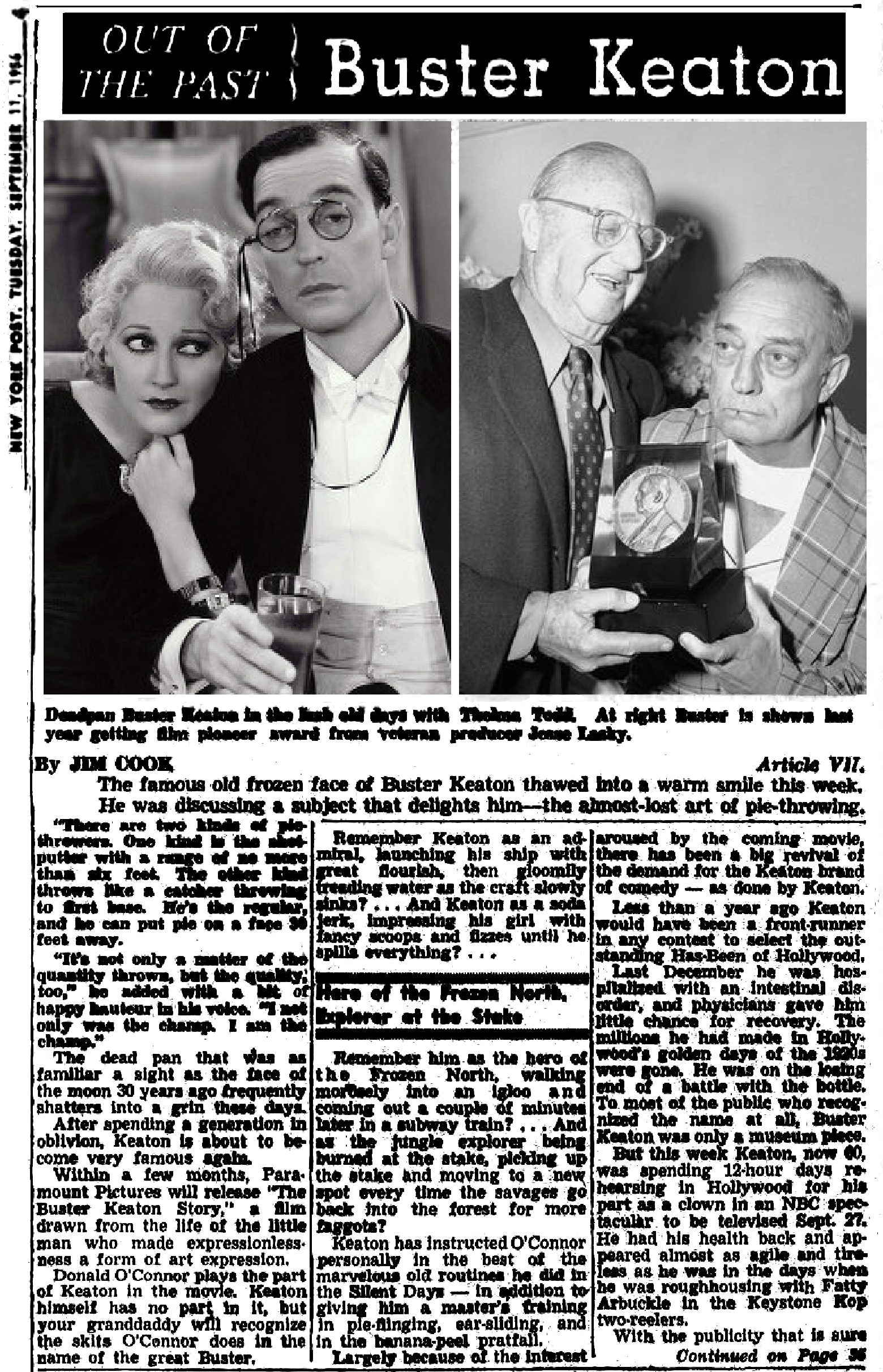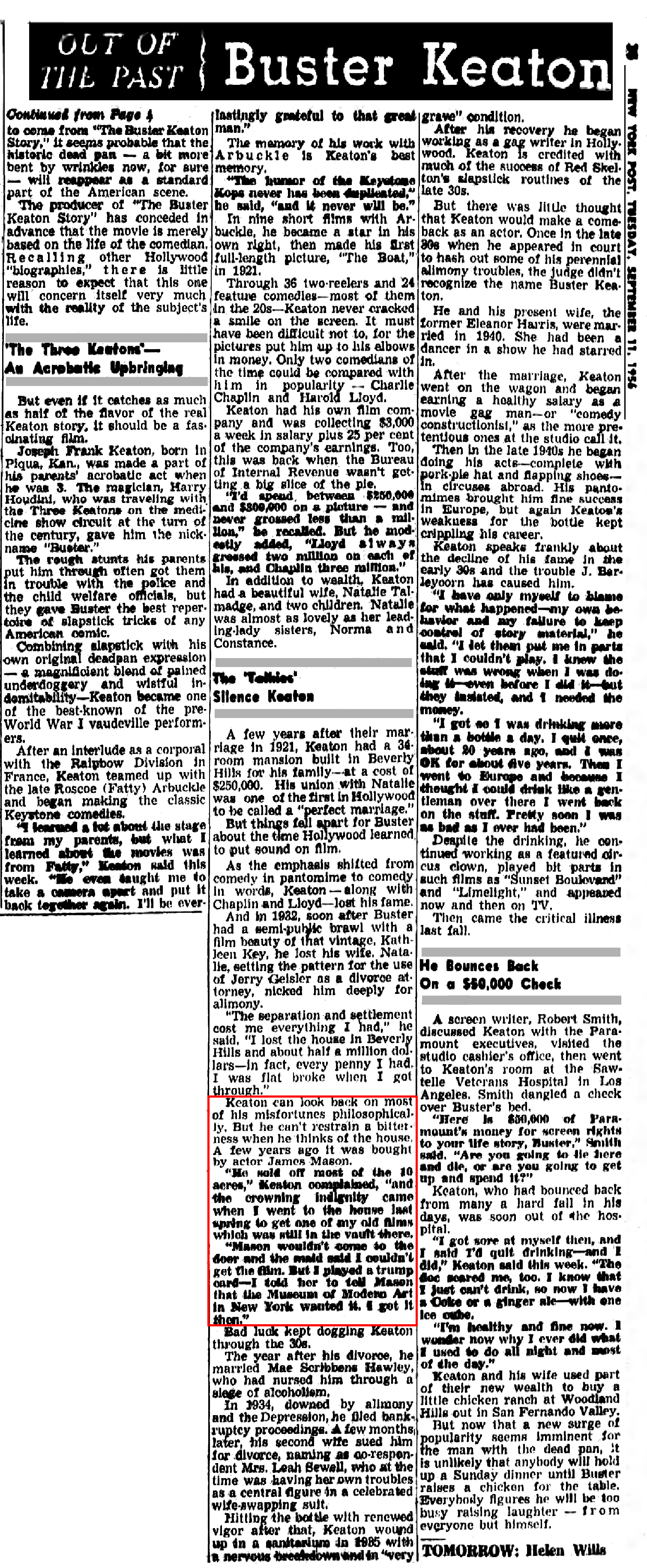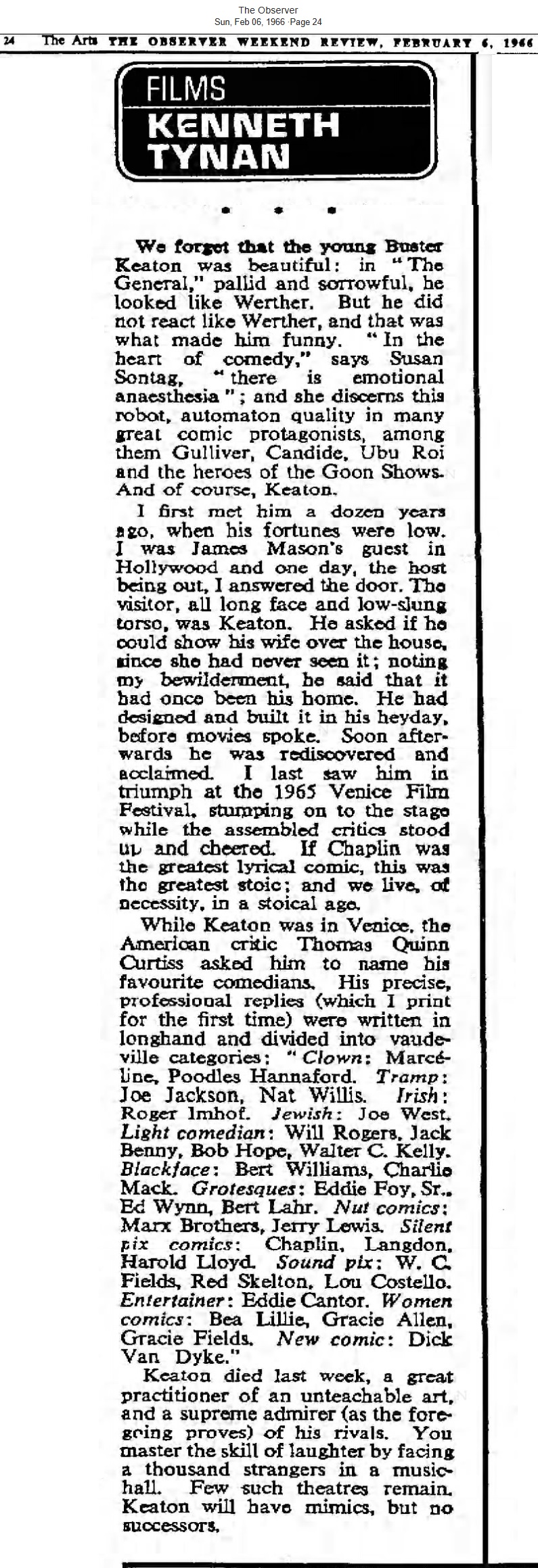The Coronet Theatre |
|
This is a tangent, and yet it is crucial to understanding Buster Keaton’s career,
even though Buster only rarely stepped inside this building.
|
|
The Coronet, 272 seats, was built in 1947 and presented both occasional live entertainment but mostly films.
The schedules embedded below give me the distinct impression that the Coronet presented 16mm only, never 35mm.
Film screenings had to go on hiatus for a few weeks or months whenever a theatre set occupied the stage.
Paul Ballard, who had run his Film Society out of his apartment,
moved his program to the Coronet and redubbed his organization
the Hollywood Film Society.
He began his Coronet film series on 5 May 1947.
To read a little bit about and by Paul Ballard, click
here and
here and
here.
I was able to take snapshots of the programs, and, yes, this is probably the complete collection.
|
|
If this does not display,
download it.
|
|
It seems to me that most or all of the films came from MoMA.
My guess is that Raymond Rohauer was involved in this from the earliest days,
and I guess that because Paul’s and Ray’s programming was so strikingly similar.
I cannot be certain of Ray’s involvement in Paul’s organization, though.
|
|
A month after Ballard’s film series opened,
the Coronet opened its first stage presentation,
Thornton Wilder’s The Skin of Our Teeth on
Wednesday, 11 June 1947.
Its second stage production was the world première of Brecht’s Galileo on
Wednesday, 30 July 1947.
|
|
For some background, you can read the Los Ángeles Department of City Planning’s
RECOMMENDATION REPORT
for the Cultural Heritage Commission.
It’s a good read with a good history.
|
Raymond Rohauer |
|
You are about to start running into lots of mentions of a certain Raymond Rohauer.
As an introduction, here is a little video.
It is inaccurate, but it will give you a pretty fair idea
of the Commonly Accepted Knowledge concerning this certain Raymond Rohauer.
And remember: Commonly Accepted Knowledge is usually wrong.
|
|
OddityArchive, Oddity Archive: Episode 208 — The Ballad of Raymond Rohauer, posted on Dec 10, 2020. When YouTube disappears this video, download it. |
|
You would be hard-pressed to find anybody to offer a complimentary word about Raymond Rohauer.
In my personal experience, the opinions of those who knew him, met him, dealt with him, or even just learned about him,
are almost entirely disparaging.
Now, I have been taking time off to plough through holdings at an archive,
where I am promised tons and tons of dirt on this certain Raymond Rohauer.
As I dig through the holdings, I am finding exactly no dirt on Rohauer.
None. Zero. Zilch. Nada.
The bulk of the horror stories I have read and heard through the years are dissolving before my very eyes,
dissolving into nothingness.
I am finding lots of unsavory information, though, about his critics.
|
|
Now, Rohauer was no angel, and he was certainly peculiar, borderline psychopathic.
He was manipulative and deceptive.
He could be really nasty at times and he had some bizarre quirks.
The result was that, as far as I know, he had no close friends, save one Kristian Chester.
From what I can gather, most people just wanted to get as far away from him as possible.
His alterations of the films under his care irk me no end and I consider those changes to be sheerest vandalism,
and yet I understand the paranoia that led him to commit those atrocities.
Ray Rohauer also had a proclivity for massaging a true story to make it reflect upon him better.
Sometimes he invented episodes out of whole cloth, and in such stories he emerged as the valiant hero who saved the day.
On the other hand, as for all the evil that is supposedly lurking in the background, well, it ain’t there.
So, please be careful.
As for the calumnies I have scribbled onto the various pages of this website, well, I apologize.
I shall scrub them away over the next couple of weeks.
For the record, yes, Ray Rohauer did indeed copy some of the films he rented from MoMA or other distributors,
but not in order to present pirate programs.
That was just his private compulsion to build a personal collection, not for public consumption.
When he ran shows at his cinemas, he rented prints and paid the fees and royalties.
He did something else, though, something that drove everybody crazy,
something that aroused hatred and indignation everywhere,
something that will earn him a favored spot in history as the centuries drag on.
I say it elsewhere and I say it here again:
History will be kind to Raymond Rohauer.
|
|
Rohauer had established the Memorable Films Society no later than December 1947.
Either through a name change or a reorganization, this evolved into the Society of Cinema Arts no later than June 1948,
and he arranged screenings in various venues.
|
|
After Paul Ballard’s Hollywood Film Society left the Coronet,
live performances continued as before, still under the sponsorship of John Houseman’s Pelican Productions.
In January 1950, Rohauer revived the Coronet’s film series, this time under the aegis of his Society of Cinema Arts.
|
|
The SCA concentrated largely on experimental,
|
|
The Coronet was
16 blocks from John and Dorothy Hampton’s Movie: Old Time Movies.
Artsy places need to be in Bohemian neighborhoods,
and yet these two movie houses were rather out of the way in the antiseptic suburbs.
Surprisingly, they each somehow attracted a loyal clientèle.
That would seem impossible, and yet it happened.
|
|
Just discovered a thesis by Micah Isaiah Gottlieb entitled
The Past and Future of Alternative Moving-Image Exhibition in Los Ángeles from 2021.
Gottlieb maintains that Ray Rohauer insisted
“on building and screening from his own personal archive of prints”
and that this “was both unprecedented and illegal.”
Predictably, there is no source for that assertion.
|
|
Now, I had searched and searched and searched and searched and searched
for months and months and months and months and months
in all the available LÁ periodicals
for any advertisement, any announcement, of Rohauer’s programming at the Coronet — all to no avail.
There was the occasional passing reference, together with plenty of items about the stage shows,
and, of course, articles about the vice squad raiding the place (for two films that displayed no vice),
but there was nothing about the film programming.
|
|
The two movies that were busted?
Fireworks and
The Voices.
They leave me totally cold and I find them hopelessly dull, but some folks like ’em, so hey.
Did you click on the links and watch them?
Did they scandalize you?
Did they corrupt you?
Were they pornographic?
Did they lead you down path of perdition?
There is a widespread accusation that the Coronet was popular among “homosexuals.”
True, but what of it?
See, for instance, Queer Maps,
which devotes a page to the Coronet.
The problem with pigeon-holing the Coronet as a queer hangout is simply that the same holds true for any place that exhibits fine arts.
The artistic crowd tends not to give a hoot about people’s hormonal balances,
and so it’s a crowd that can serve as a good refuge for those who wish simply to unwind and be themselves.
The implication that the Coronet was a hotspot for perverts was preposterous.
Please, folks, please stop saying that, now.
(I use quotation marks because the word is an adjective, not a noun, despite popular usage.)
How is this summarized in the mainstream media?
Here is John Baxter’s assessment, published in The Sunday Times Magazine, 19 January 1975, p. 32:
“In October 1957 the police swooped on the Coronet
and arrested Rohauer for exhibiting a number of pornographic homosexual films.”
Curiously, the State Assembly Subcommittee on Pornographic Literature
got Ray into legal trouble, yet again, for showing “lewd movies” and “smut.”
The movies in question:
Monkey into Man,
an educational film from 1938, by Strand Film Zoological Productions Giving the Rorschach Test: Klopfer Method, a health-education film from 1951, produced by the City College of New York Human Reproduction, from 1947, part of Sex Life of the Rhesus Monkey, an educational film distributed by Pennsylvania State University; I suspect that the correct title was Social Behavior of Rhesus Monkeys from 1947, part of the “Clarence Raymond Carpenter Primate Studies” series offered by Pennsylvania State University’s Psychological Cinema Register Birth of a Child, which I am unable to identify; there is a description in the scrapbook below; if you can identify this film, please contact me; thanks! Experiments in the Revival of Organisms, distributed by the Un chien andalou, the repulsive and boring but popular Buñuel/Dalí silent from 1929 El, Luis Buñuel’s 1953 thriller in general release through Columbia Pictures.
That’s pornographic????? That’s lewd smut?????????? Gimme a break.
The controversy above led to support in San Francisco:
|
|
Anyway, the utter lack of publicity convinced me that the Coronet must have been a private club that never advertised.
What I did not realize was that there was one newspaper, probably only one,
that accepted advertisements for and press releases from Rohauer’s screenings at the Coronet.
Well, that changes my story, doesn’t it?
This was a newspaper I had never heard of before, the Los Ángeles Evening Citizen News.
But the advertisements and press releases ceased after a mere few months.
A second newspaper, the Daily News, also made a few rare mentions of Rohauer’s programming,
but I had never caught them before, surely because the paper had not yet been fully OCR’d and indexed.
|
|
So, here we go. Below we have the beginnings of a scrapbook.
It is a scrapbook in progress.
It may never be complete.
As I find more, I shall add more.
It consists of items dealing mostly with Ray Rohauer and with the Coronet Theatre.
I included other items, such as movie ads that mention neither Rohauer nor the Coronet,
but I include them only for the sake of context.
Use the scrollbar or the mousewheel on the below window to go through the various clippings.
|
|
If the above scrapbook does not display,
download it.
|
|
Might you have any Coronet-Louvre / Society of Cinema Arts programs in your collection?
If so, please let me know.
I shall happily pay for scans, which I would like to post here.
I have seen only a few, poor thermal photocopies of poor thermal photocopies,
and further copying is strictly forbidden.
|
|
What was Raymond Rohauer’s great offense?
What did he do that made everyone so angry, indignant, resentful?
From his teen years, he did the same thing that John Hampton did.
He started collecting 35mm nitrate film, rejects that he claimed to have found in attics and basements.
Yes, that is where films could be found.
Heck, they could even be found in newspaper classifieds.
|
|
Many of these films were commonly believed to be in the public domain,
but the public domain is a tricky topic.
Though a film can be in the public domain in the US, it might not be in the public domain elsewhere in the world.
Further, even if the film is truly in the public domain, it could be based on underlying works that still have valid copyrights.
Rather than risk breaking the law, Ray Rohauer set about searching high and low for anyone who might control the underlying rights.
He found elderly widows and descendants who had not even been aware that they owned these properties.
He drafted contracts by which they would either sell him their rights or license those rights to him.
So, other companies and various museums who thought they owned films
suddenly found themselves confronted by a peculiar nebbish
who waved copyright registrations in front of them and threatened them with suit if they continued to hold screenings.
That is why everybody hated his guts.
|
|
At the Margaret Herrick Library in Beverly Hills,
you can request a pair of file folders donated by Anthony Slide,
both dealing with Raymond Rohauer.
Inside are photocopies of a two-part interview published in a tabloid called MARBLE.
I have searched but can find no reference to this periodical anywhere.
At the top of one of the pages is a section subheading:
“Film News and Comment.”
Evidence in these photocopies indicates that this was a local New York City
publication,
|
|
Since this publication is so exceedingly rare and unavailable in any library,
I shall take the risk of reproducing the text portion of the interview in full.
If you own the rights to this article,
just drop me a line and we’ll make things right.
|
|
MARBLE [July/August 1975] Film News and Comment
Presenting Raymond Rohauer...
By Scott Isler
Ask various people in the film business
about Raymond Rohauer and their
comments most likely will range from the
complimentary to the slanderous. The
public, if it is aware of him at all, is
probably most familiar with the
“Raymond Rohauer presents” title cards
that linger on the screen at the beginnings
of the old films he circulates. His name is
there because Rohauer owns the rights to
those films, most of which were made
before he was born. This seems to be what
some people hold against him: a resentment
that he is making money from the
work of others, despite the fact that
without his diligence, many of these films
wouldn’t be available at all.
Rohauer, a likeable, conservatively-dressed
figure, describes himself as a film
collector but uses a very exclusive
definition. “Real film collecting is getting
an original copy of something,” he
maintains. “Film collecting is not buying
prints. Anybody can collect films by going
around from store to store and buying
them but real collecting is almost a
finished art now.”
By “real collecting” Rohauer means the
acquiring of movies printed on nitrate film
stock. Nitrate, a gunpowder base, was
used for flexible film stock until the end of
the 1940s when it was superceded by
acetate (“safety”) stock. Nitrate prints,
besides being highly combustible, also
decomposed rapidly.
Rohauer can trace his interest in
collecting films back to when he was about
14 years old. That was in the early 1940s.
Although born in Buffalo, he later moved
with his family to Los Angeles, a location
that would encourage anyone’s budding
interest in film. It must have been fertile
ground for a film collector; Hollywood has
always been notoriously lazy about
preserving its filmed past and thirty years
ago there were undoubtedly more old
films lying around than there are now.
“You search out, you find out who had
films and what they were” is Rohauer’s
self-described technique. He would find
films in attics or garages. “It’s a matter of
research. It’s a very tedious and
unrewarding work because you’re not
doing it for commercial reasons. You’re
just doing it because you want to do it.”
While a student at Los Angeles City
College, Rohauer headed a film society
and in 1947 persuaded D.W. Griffith to
appear at a screening of The Birth of a
Nation. It was one of the director’s last
public appearances (he died the next year)
and Rohauer recalls that the reluctant
Griffith showed up only through
Rohauer’s persistence.
In 1950 Rohauer took over the Coronet
Theater in Los Angeles. Previously a
home for unsuccessful stage productions,
he turned it into a movie theater and,
more particularly, a showcase for his own
taste in old films. “I didn’t want to run a
commercial theater. The whole purpose
was to run classic films.”
The Coronet gradually acquired an
audience and its eventual success led
Rohauer to manage two other theaters in
Los Angeles. Among the people who
worked for him at this time was a young
usher named Stan Brakhage who wrote in
1969 that the Coronet was “the best
theater for regular presentation of filmic
works of art ever created yet in this
country.”
Rohauer cont’d.
The lack of availability of old films from
commercial distributors at that time
reinforced Rohauer in his quest for film.
In 1962, when his theaters’ leases expired,
he realized that film sleuthing was a
A few years later, in 1965, Rohauer
became the film curator at Huntington
Hartford’s year-old Gallery of Modern Art
in New York City. He was contacted for
the job by the Gallery’s director, Carl
Weinhardt, who had heard of Rohauer’s
activities in film. Rohauer, always his own
man, accepted on the condition that there
be no interference, from Hartford or
anyone else. He then proceeded to create
a film department with a populist slant, at
least partly so as not to mimic the activities
of the Gallery’s neighbor, the well-established
Museum of Modern Art.
“It was not my interest to duplicate
anything or to approximate what the
Museum had done,” Rohauer recalls. “But
in doing research about the Museum of
Modern Art I realized there was so much
that wasn’t done. They were not fulfilling
the needs of the people because they have
a very snobbish attitude about what they
consider to be good, what they consider
should be shown to the public.”
As an example, Rohauer cites one of the
first programs he did at the Gallery,
honoring comedy producer Hal Roach. “I
first contacted Richard Griffith [then
MOMA’s film curator] because the Hal
Roach thing came up too early when I first
got to the Gallery and I wasn’t ready for it
technically. So I offered it to the Museum
of Modern Art. Richard Griffith sent me a
telegram: ‘No, we’re not interested in Hal
Roach. Period. Signed, Richard Griffith.’”
Rohauer’s aesthetic vindication came five
years later when the Modern finally did
honor Roach.
Similarly, the Gallery of Modern Art
held a Ginger Rogers retrospective (“one
of the most successful programs I ever
did,” says Rohauer) after the idea had
been rejected twice by the Museum of
Modern Art. But Rohauer’s biggest
triumph while at the Gallery undoubtedly
was with someone else the Modern
wouldn’t touch : Busby Berkeley.
“That started in the early part of ’65.
When I first talked to Busby Berkeley I
said I wanted to do a tribute to him in
New York. He said, “Well, you’re nuts!
Nobody knows about me. I’m forgotten. A
tribute about what?’”
Rohauer persisted, the same way he
kept after D.W. Griffith nearly 20 years
earlier. Besides wanting Berkeley to make
a public appearance he also went after
Ruby Keeler, at that time, like Berkeley,
totally retired. Keeler was evenmore
reticent about acknowledging her
cinematic past than Busby but finally
agreed to appear in Berkeley would.
Berkeley reciproctated Keeler’s
agreement and they were both flown to
New York for the show, which opened in
November, 1965.
“We had people lined up around the
block trying to get in,” Rohauer says. The
program itself was made up of Berkeley’s
dance sequences from the Warner
Brothers musicals of 1933–37. After it
finished playing New York, Rohauer took
the films, plus Berkeley and Keeler, on a
month-long tour of London, Paris,
Switzerland and Germany. There was
unanimous acclaim for the films, and
Berkeley and Keeler, at first astonished
by the reception, realized that there was
still an audience for their work.
“It was really one of the most
exhilarating experiences I’ve ever had but
it was also one of the most difficult things
I ever did,” admits Rohauer. “The
problem with Busby Berkeley and Ruby
Keeler was temperament, particularly
Berkeley who would feel he had to pit
himself against me every day and a
number of times a day. He would always
try to do the Big Director and he would
act as I was his employee. He treated
Ruby Keeler the same way. She was used
to it. She worked for him for years but I
was not used to it.”
Rohauer’s solution was simply to avoid
Berkeley, meeting him only for the show.
The day they were returning to New York
Berkeley called on Rohauer, apologizing
for his behavior and explaining that a
week before he came to New York he had
had an operation for a possibly cancerous
growth. Not wanting to jeopardize the
tour, Berkeley had kept the operation a
secret but during the tour was suffering
from after-effects.
“He wanted me to understand, now that
it didn’t make any difference, why he was
so difficult," Rohauer explains. “‘But, you
know, Ray,’ he said, ‘I will always be
grateful to you for what you’ve done.’”
[PHOTO: Rohauer, Wm. Wellman, Ruby Keeler and Busby Berkeley at Gallery of Modern Art (1965).]
Rohauer resigned from the Gallery of
Modern Art at the end of 1967. He had
been preparing a father-son program of
works by Max (“Betty Boop” and Richard
Fleischer when Huntington Hartford
either suggested (acording to Hartford)
or demanded (according to Rohauer) that
Richard Fleischer give Hartford’s wife a
screen test. A large portion of the show,
the first tribute to Max Fleischer ever
held, was cancelled. Rohauer left, feeling
that his independence had been compromised.
He is amused today when he
recalls that Hartford was “bowled over”
by the resignation.
In 1969 Fairleigh Dickinson University
bought the Gallery of Modern Art,
christened it the New York Cultural
Center and asked Raymond Rohauer to
come back, promising complete autonomy.
He accepted (the film department had lain
dormant since his resignation) only to
meet more interference: not from Dr.
Peter Sammartino, the Center’s director,
but from Sammartino’s wife.
“She wanted to see what the programs
were in advance, what the program notes
were; if there was anything a little sexy or
out of the way or different, it had to be
dropped. I refused to do it,” Rohauer
resigned again in 1970.
By then, however, he was ready with
his biggest indpendent film program
to date: the films of Buster Keaton.
[This is the first of a 2 part article on
Raymond Rohauer. Ed. Note]
MARBLE/ Page 3 [Sept-Oct 1975]
Presenting Raymond Rohauer... Part Two
By Scott Isler
Rohauer’s relationship with Keaton
dated back to 1954
when Keaton, aware of
Rohauer’s reputation through the Coronet
Theater, approached him and told him of a
collection of films Keaton had stored in his
garage. Rohauer went and found THE
THREE AGES, THE NAVIGATOR,
SHERLOCK JR., GO WEST, STEAMBOAT
BILL, JR., COLLEGE, some two-reel
shorts... all original nitrate prints
and all in various stages of decomposition.
Rohauer had the films transferred to
safety stock before any more damage
could be done and then went about untangling
the problem of commercial
exhibition rights so the films could be
shown again.
At the same time as he was
straightening out the legal difficulties
Rohauer was also looking for Keaton films
that Keaton himself didn’t have. Some
two-reelers were found in eastern Europe
with titles in Czech, Russian and Polish. In
all, Rohauer amassed 21 Keaton shorts
(more have since been found) and all 10
features made by Keaton’s own
production company. After clearing the
rights Rohauer showed some of the films
in London but the first full presentation of
the Keaton legacy took place in the fall of
1970 at New York’s Elgin Cinema.
“The Keaton thing to me was the most
rewarding, personally, of anything I’ve
ever done,” says Rohauer, and the explosion
of interest in Keaton which the
reissues sparked certainly confirms his
claim that “I consider this my most important
work.”
Since 1970 Rohauer has continued
accumulating film and the rights to
exhibit them. He is a businessman, of
course, but one who uses his pragmatic
knowledge to further aesthetic ends.
THE THREE AGES, for example, was
the first Keaton film Rohauer had
restored and the most seriously damaged
by deterioration of all Keaton’s garage
films. Rohauer explains “I used
psychological means” to get a film lab to
reprint it.
“I had Buster Keaton himself personally
deliver the nitrate original to the
superintendent of the lab. This man was
so impressed meeting Buster Keaton that
he took them. Then I went in afterwards
to place the order. So they went ahead
and they started making a dupe negative
with the emulsion running on the film.
The emulsion was coming off the film
during most of the printing so they
claimed it destroyed a $15,000 printer.
They stopped doing business with me
after that. I felt that all I cared was
getting a negative made and there were
many more laboratories to deal with. I
would ruin 10 to 20 more printers in
laboratories if it meant saving the films.”
Rohauer has a film-lover’s reverence for
celluloid. In THE THREE AGES there
was never any thought about cutting out
damaged portions. “I go to great lengths
to see that every piece is printed. Even if
[a film] is rejected by one lab I will keep
going from place to place even to other
cities, to get it done.”
Hunting for films is mainly a matter of
research (Rohauer has no staff or office)
although there is more than a bit of luck
involved. The original camera negative of
Alla Nazimova’s 1922 production of
SALOME was found by Rohauer in the
wine cellar of Nazimova’s hotel in
Hollywood.
[PHOTO: Rohauer and Keaton at Venice Airport (9/1/65).]
There have been more fortuitious incidents.
“I met a newspaperman from
Holland at the Berlin Film Festival. He
said he had 16mm. prints of some Harry
Langdon shorts. I asked what were the
titles and he said he could only remember
one of them called something like THE
LITTLE DUTCH GIRL. Langdon never
made a picture with that title. He sent me
the print. It was in poor shape, the titles
throughout were in Dutch and we couldn’t
identify it for some time. So I had to go
through the synopses of Langdon’s 25
two-reelers for Sennett to locate the
story-line that would fit this particular
short and we did find it. It was a film
called THE SEA SQUAWK made in 1925
and this is the only copy in the world that
I’ve ever found of THE SEA SQUAWK.
“I never really consider any film lost.
I’ve seen lists that are published by the
American Film Institute and the Museum
of Modern Art that claim that such and
such a film is lost. Now I may even have
copies of these films that they consider
lost. Just several weeks ago the AFI made
an announcement that there were six
Frank Capra films lost forever. Well,
that’s not true because one of them, THE
POWER OF THE PRESS, I happen to
have the 35 mm original material on. Now
the Institute knows this and they tried to
get it from me and I wouldn’t give it to
them. They didn’t say ‘Well, we did locate
POWER OF THE PRESS and Raymond
Rohauer has it.’ They just say it’s lost.”
It is in the area of commercial rights
that Rohauer has made the most enemies.
“I went into it in a depth that no one else
ever went into. I didn’t just do it on a
superficial level; I tried to understand the
copyright law. Many attorneys today still
don’t understand what it’s all about. Even
Congress is trying to rewrite the
copyright law to this day to cover modern
technology.
“Film is just like furniture or any other
property; it has an owner. Copyright is
the intangible right but film itself, the
physical thing, is tangible. The intangible
right, if you are the copyright owner,
gives you the exclusive right to make
copies, to distribute them and release
them. The property right is the physical
aspect but that’s not the copyright.”
A film copyright is good for 28 years
after which it may be renewed for another
28. Many film companies let their
copyrights lapse on old films, others went
out of business. Tracking down owners of
copyrights and clearing films for public
release can be second in difficulty only to
finding copies of the films themselves.
Once he acquires rights to a property
Rohauer isn’t lax to assert himself. For
broadcasting Buster Keaton’s THE
GENERAL in December 1965, he
brought action against New York’s
Channel 13 (WNET) and five lawsuits
against the Museum of Modern Art, from
whom the station had obtained its print.
Demanding that MOMA surrender its
prints of the film to him, Rohauer settled
for an agreement by which the Museum
would stick to the restrictions imposed by
film donors (i.e., no commercial uses).
Channel 13 agreed not to show THE
GENERAL again without Rohauer’s consent.
Although his activities may parallel
those of film archivists, Rohauer is
definitely in it for the money, a distinction
that gains him the wrath of archivists.
Rohauer views it as jealousy, the fact that
he got there before they did. The most
recent and vicious example of
Despite such unpleasantries Rohauer
seems the sort of person who always
maintains a cool exterior. It is the calm of
someone who knows what he’s doing, does
it well and is completely self-reliant.
Above all Rohauer treasures his
autonomy. “I like to be free, not to be tied
down to any office. It’s my nature not to
be pinned down. No one’s ever been able
to do that — Huntington Hartford, or no
matter who it is. The independence I will
never give up.”
Independence and a passion for film:
His own collection numbers well into the
thousands and Rohauer, afraid of fire,
catastrophe or even war, makes copies
and stores them in different countries.
Not all of these films, of course, are of
artistic or commercial interest.
“I certainly have to be dedicated to
what I’m doing to save films that have no
value as yet, maybe won’t have value for
many years to come; but that’s not important.
The thing is it must be done
now.”
Perhaps some future generation, less
concerned with Rohauer’s financial interests,
will look more kindly on his
single-minded attitude to film preservation.
“With me it’s all film. The only thing
that really draws me to anything is
film... I wouldn’t do anything else.”
[Another page of “Raymond Rohauer Presents...” was authored by Andrew Markowsky,
who pulled details from a press release about the Rohauer program at the Elgin.]
|
|
Not everything in the above interview is true.
Some of the information is fractional and some is tendentious.
We also need to be wary of the omissions.
When did Ray begin collecting Buster’s movies?
The implication is that the quest began in
1954,
when Buster and Ray first met.
I am now convinced that
1954
was indeed the year they first met, likely in the summer.
An examination of the flyers would pin this down with certainty, but I am unable to locate those flyers.
Jim Curtis makes a powerful case that they first met in
1958,
but as overwhelming and seemingly irrefutable as his evidence is, he’s wrong.
Further, Ray had already shown at least four Buster shorts at the Coronet several years before he met Buster,
but whether he had those films in his personal collection or whether he just rented them from distributors, I do not know.
|
|
It is interesting how Ray maintained that his film collection began
by inquiring about leftovers in attics or garages.
Perhaps he did that, but when you read Kevin Brownlow’s The Search for Charlie Chaplin
you discover that Ray was sniffing about in more than attics or garages.
He had contacts at warehouses and at exchanges and at silver-reclamation labs.
Ahhhhhhhhhh.
When a film was scheduled to be tossed out or chemically dissolved,
these contacts would work out behind-the-scenes arrangements to deliver these films to Ray instead.
Now, think back, back to
the interview with John Hampton of the Movie: Old Time Movies
in Los Ángeles.
John told of how he began his youthful hobby of collecting disused nitrate films
by purchasing them for a dollar a reel from the local exchanges
and also by dumpster diving at those exchanges.
Ray surely engaged in that identical activity, in Buffalo as well as in Los Ángeles,
and he expanded that enterprise beyond mere dumpster diving.
|
|
Ray was not alone in his quest.
There was another detective sniffing about for Buster’s films,
and this is where things get really complicated.
|
Rudi Blesh |
|
Olga Egorova sent me some fascinating materials,
materials that change so much of the narrative I had pieced together.
In earlier drafts of this website, I had postulated that it was Robert Smith and Sidney Sheldon
who had most likely begun the hunt to locate and recover Buster’s silent movies.
My idea seemed to fit the known evidence, but I was entirely wrong.
It was actually Rudi Blesh who had begun that hunt.
Robert and Sidney were the beneficiaries of Rudi’s efforts.
|
|
Olga’s clipping files proved that my memory is too malleable.
I read Rudi Blesh’s Keaton in 1975,
having checked it out from the just-opened
downtown Albuquerque Library,
the smelliest library on earth, but the book was not complete.
A previous patron had clipped out some photographs, and so the text on the reverse was missing.
Nonetheless, I devoured the book.
I have not read it in its entirety since that time,
but I do have it in my collection (three copies, really), and I rather frequently page through it again.
|
|
As I learned at the 1999 Busterfest in Muskegon, Rudi’s book was originally much longer.
What went to press was an abridgment.
That seemed obvious to me.
The years 1895 through 1928 fill 307 pages, but then 1929 to 1966 are a mere 63 pages.
That left me craving more information about those 36+ years.
That is why I concluded that the publisher decided largely to omit the second half of Buster’s life.
|
|
Wrong!
|
|
Oliver Scott interviewed Eleanor for his privately printed book,
Buster Keaton, the Little Iron Man,
and I read but then completely forgot Eleanor’s words.
And my goodness, did she ever have words!
Among the things she said, page 317:
“...But the last ten years of Buster’s life he put in two chapters
tacked on the end, after Buster died. He said that he was only interested in silent
film, and when silent pictures went out, he quit worrying about it, the end of the book.”
|
|
Now that we have a bit of context, we can explore.
Rudi had seen Buster’s silents and talkies in the 1920’s and 1930’s when they were new.
In his Preface, dated 1966, he wrote,
“It was a dozen or so years ago that I began seeing the Keaton films
again, at the Museum of Modern Art. It proved far more than an
indulgence in mere nostalgia. It was, in fact, a startling experience.
Cops,
The Boat,
The General,
Our Hospitality,
The Navigator — and
all the rest — were a revelation.”
It was then that Rudi decided to meet Buster in person and write his biography.
For this past half century, I had taken Rudi at his word.
I had no reason to quarrel with his assertion that he began watching Buster’s movies at MoMA
a dozen years prior to 1966, or, if we employ the simplest arithmetic, in
1954.
Even so, there is a problem, and you can probably spot it.
In 1954,
MoMA had 35mm lavenders and 16mm prints of
Sherlock Jr.,
The Navigator, and
The General.
In addition, it had one 35mm nitrate print each of
Our Hospitality and
Go West.
MoMA may or may not have had a copy of Cops but it most certainly did not have The Boat.
There was, though, a 16mm copy of Cops that was making the rounds.
Who distributed it, I do not know.
In
September 1953, the Sioux Falls Community Playhouse announced an upcoming screening of Cops on 28 March 1954.
The Goat was also available in 16mm from some distributor somewhere.
It was almost certainly pirated.
It was shown at the Eaglet in Sacramento in
February 1954.
What other Buster silents may have been floating about, heaven only knows.
There was certainly not much.
|
|
If you are like most people, you are now fed up with me for taking issue with such a small matter.
Whether Rudi saw those movies at MoMA in 1954 or 1964 or sometime in between hardly matters.
What matters is that he saw those movies at MoMA, and so why am I obsessing on this trivia?
I’ll tell you why.
You see, that tiny bit of trivia contains a telltale clue,
a telltale clue that unlocks a massive mystery.
What’s more, Rudi did not start watching Buster’s movies at MoMA in
1954,
but in
1952.
It was at MoMA that Rudi started the process of rewatching the movies,
but he nowhere says that he continued rewatching the movies at MoMA.
(Pay attention to that seemingly innocuous employment of unspecific language
that makes us think we read something that we did not actually read.
Rudi will use that device again in an interview, as we shall see.)
He continued his viewings elsewhere.
There was only a single night of MoMA/Buster screenings, as far as I can determine,
and that single night was not even at MoMA.
Shall we?
|
|
That evening at the Brooklyn Academy of Music (BAM) surely was not a five-hour marathon of five of Buster’s features.
It was probably only two of those features.
|
|
Now, I would wager that Rudi eventually arranged with a curator (Richard Griffith?) to view the other films.
Three features were available in 16mm, and the two nitrates he probably viewed on a flatbed editor.
|
|
On the page before Rudi’s Preface appear the Acknowledgments, which I read in 1975 and never
|
|
James Mason’s story can wait a little while, though.
Let’s get back to the beginning of Rudi’s adventure,
which we learn about in Kevin Brownlow’s Alla ricerca di Buster Keaton, pages 25–26.
Rudi leaves us with the impression that it was immediately after watching a few Buster movies
on that evening of Wednesday, 12 March 1952,
that he sought Buster and learned that he was headed for New York.
We need dates on this story.
Jim Curtis provides them (pp. 566–567).
The process was not immediate after all.
In fact, it was not until a year and a half after that screening that Rudi met Buster.
Buster and Eleanor returned from three months of variety revues touring
Italy
(July through September 1953).
They sailed from Le Havre aboard the
RMS Mauretania
(Rudi later misremembered this as the Queen Mary).
Rudi sent Buster a
radiogram:
“WOULD LIKE TO WRITE YOUR BIOGRAPHY.
IF INTERESTED CALL ME WHEN YOU REACH NEW YORK.”
(Oh how much I would love to learn what Rudi and his publisher offered to pay Buster for the privilege.)
Buster and Eleanor disembarked in New York City on Monday,
5 October 1953.
They took a room at the Hotel St. Moritz
on Central Park South, and Buster indeed called Rudi.
The following day, Buster and Rudi met in Central Park.
That was on Tuesday, 6 October 1953, as Jim Curtis confirms (p. 566).
Buster was agreeable to a biography,
but only on condition that his life story be told truthfully, without any whitewashing.
“I was on the crest of a wave — and then I blew it.
I don’t want any retouching.”
|
|
We have a variant version of the above episode.
Carl Hultberg privately published Rudi (and me): The Rudi Blesh Story (told by his grandson)
(Ragtime Press, PO Box 913, Orleans MA 02653, 6 November 2013, $18.99).
His memories were imperfect and his resources were lacking.
He did the best he could with imperfect memories and fragmentary documentation.
Page 67:
|
|
Buster Keaton had been a popular silent movie comedy star in the
1920s when Rudi was young. Whatever happened to the guy?
Had anyone ever written a book? As it had been with the Ragtime
story it was Hansi [Harriet Janis, Rudi’s wife] who had asked the original question. The
instigator. Rudi investigated and found that nothing of real
importance had been written regarding this compact extremely
graceful doleful yet indomitable character. Determined to contact
Keaton right away (1954) Rudi got in touch with the outfit whose
job is to know the location of every star at any given time,
Celebrities Incorporated. Where was Buster Keaton and what was
he doing? The answer: Buster was on the steamship Normandy
sailing to England on his way to France, where he still appeared
as a headliner at the time. Not wanting to waste another minute
Rudi immediately wired Buster by short wave radio, Ship to
Shore. “Would he consent to allow Rudi to write biography” Rudi
said that Buster was so impressed that someone would go to all
the trouble to reach him on board ship that he agreed on the spot.
|
|
See? I told you it was a variant.
Rudi wrote in his Preface that he decided to write about Buster
immediately upon seeing some of Buster’s silents at MoMA in 1954.
Yet, as far as I can determine, there were no MoMA screenings of Buster’s silents in 1954.
There were screenings, courtesy of MoMA, at BAM in 1952.
Carl tells us that the idea for the book was not Rudi’s at all, but his wife Hansi’s,
and he implies that Hansi got that idea in 1954.
Makes sense.
Rudi saw some Buster movies in 1952 at BAM and spoke about them often enough
that Hansi bellowed forth with, “Well, why don’t you write a book?”
That is when Rudi checked to see if there was already a book and discovered that there wasn’t.
Celebrities Incorporated informed Rudi that Buster was in the middle of the ocean
but could be reached by a Ship to Shore radiogram.
|
|
Rudi told Kevin that he contacted the ship when Buster was returning to NYC at the beginning of October 1953.
Carl wrote that Rudi contacted the ship when Buster was leaving for France by way of England in January 1954.
Rudi remembered that the ship was the Queen Mary, but the passenger manifest on
Ancestry.com reveals that the ship was the RMS Mauretania.
Carl says that the ship was the Normandy [sic; actually Normandie] during its voyage to England in 1954.
Ancestry.com records a ship manifest for the S.S. Ile de France
departing NYC on 30 December 1953 and bound for Le Havre,
indicating that Buster and Eleanor planned to stay abroad for three months.
That was a later trip, though, for the Cirque Médrano and for British television.
Do you begin to understand why I never accept any account of anything as accurate?
This is why I
|
|
Rudi spent several weeks, over the course of two years or more, October 1953 through probably June 1956,
at Buster’s house at 1043 South Victoria Avenue in Los Ángeles,
interviewing him on reel-to-reel tapes.
Buster was quite open and expansive, with a memory that was surprisingly detailed and accurate.
Unlike many interview subjects, Buster was a true raconteur and he explained stories fully,
invariably utilizing the classical
|
|
We need to jump ahead two decades.
|
|
On 18 December 1972, Raymond Rohauer interviewed Marion Mack on stage for a screening of The General.
That took place at the
Ontario Film Theatre, housed in the Ontario Science Centre,
770 Don Mills Road, Toronto.
The interview appeared in print in Richard Joseph Anobile’s photonovel,
and one of the comments that Ray made on stage was,
“Back in the early fifties, when I ran a theater in Los Ángeles,
Buster Keaton himself used to buy a ticket like anyone else, because none of my ticket takers recognized him.”
With that quote, we can segue into the best book about Buster ever printed.
|
|
The best book about Buster, the best book of all, is an unofficial, unlicensed volume
|
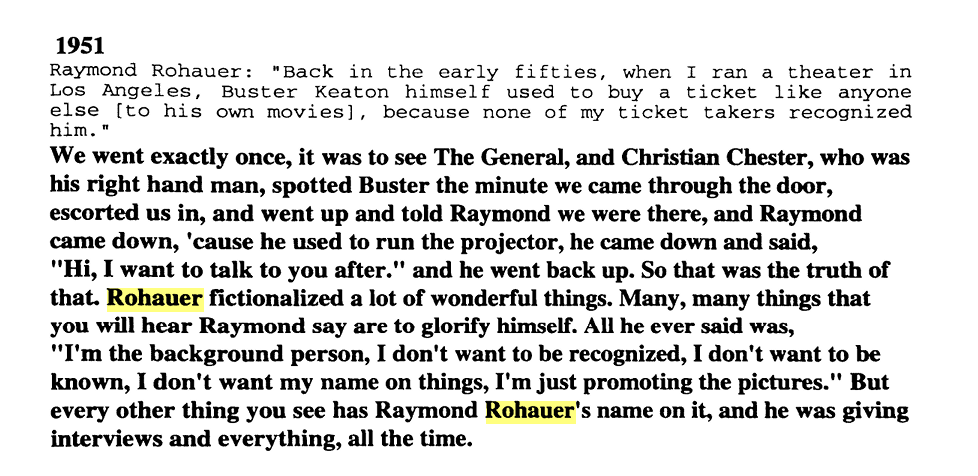
|
|
Eleanor was in the Coronet exactly once.
She did not realize that Buster later returned on his own.
That in itself tells us something.
Buster attended likely because Ray invited him.
Eleanor didn’t bother because she had precisely zero interest in such things.
So Buster went on his own.
Whether he told Eleanor where he was going remains a question to which we shall never know the answer.
When he got back home, though, we can be pretty sure that he never mentioned his little outing.
Actually, I would hazard a guess that he returned with some frequency to watch his own movies,
whether Ray showed them privately or publicly.
|
|
I had been under the misapprehension that the Coronet was a private members-only club.
As such, it would not have had or needed a ticket booth.
Well, to my surprise, yes, there was a ticket booth at the Coronet.
|
|
Many nights, but not all nights, the Coronet operated strictly as a private club and admittance was only for members.
On other nights, the doors were open to anybody who wanted to see a show.
Stage plays were probably all open to the public.
Some but not all films were for members only.
My guess, which is only a guess, is that underground films
that had not been made under the MPPDA jurisdiction were necessarily shown only to members,
but that more commercial films with MPPDA seals (or equivalent) were made available to anybody.
Educational films, documentaries, university films, and films made for classroom or medical use
were probably exempt from such standards and were probably open to the general public.
After a few months of operation, the Coronet no longer announced its films in the newspapers.
Instead, the Coronet mailed schedules to members.
So, now let us ponder that one particular show that Buster and Eleanor attended in the summer of 1954.
If the Coronet did not advertise, then how on earth did Buster and Eleanor know to show up to buy tickets?
|
|
Olga Egorova, once again, came to the rescue and supplied this gem from an unpublished interview in
Marion Meade Buster Keaton Research Files at the University of Iowa:.
|
|
Marion Meade: Right. Let me get... Let me start at the beginning with Ray.
When you first met him, what was your impression of him? He was quite young then.
|
|
|
Eleanor Keaton: Oh, yeah. He was very young.
|
|
|
Marion Meade: He was a young.
|
|
|
Eleanor Keaton: He was just a avid film fan, is all you could say.
He was running, managing the Coronet Theater on La Cienega.
|
|
|
Marion Meade: Is that the one... I thought... Like a studio. Right.
|
|
|
Eleanor Keaton: In the front. Yeah. Lovely theater inside, 750 seats, I think.
|
272 seats. |
|
Marion Meade: Is it still a theater?
|
|
|
Eleanor Keaton: Oh, yeah. They do real shows in there now.
Anyway, we saw an ad in the paper that they were going to be doing The General.
Buster says, “Let’s go see it
in a real theater.”
In fact, I don’t think
I’d ever seen it.
“Let’s go to the movies.”
So we went to the Coronet and paid our two dollars.
Christian Chester, the old man, his “adopted father,” Raymond’s —
|
It was not advertised in the paper. Note the wording! Eleanor almost certainly had seen it already, but in a clubhouse, not “in a real theater.” Kristian Chester. |
|
Marion Meade: I didn’t know who he was. I didn’t know —
|
|
|
Eleanor Keaton: Raymond’s parents were killed when he’s not too old,
and Chris practically raised him, I guess. Of course, he was a friend of the family.
|
Ray was born out of wedlock on 17 March 1924.
His mother was Rose Mary Fiebelkorn,
5 July 1893 in Buffalo through 18 May 1952 in Los Ángeles.
She bestowed the father’s surname upon Raymond, though in his teens he was known as Raymond Fiebelkorn.
(For whatever it might be worth, his |
|
Marion Meade: I see.
|
|
|
Eleanor Keaton: And then I found out later, after Raymond died,
he had a |
Ray had three |
|
Marion Meade: So you went and you saw —
|
|
|
Eleanor Keaton: We went... Chris saw us and recognized Buster, of course.
So we went on.
At the end of the movie... Because Raymond was running a projector up above,
and at the end of the movie, he’s up there like this and started talking and this and that.
And Buster said, “Well, I got a bunch of films in the garage. You can have them if you want them.
They’re only going to sit there and spoil.”
Of course, he came to the house, and that started it.
|
|
|
Marion Meade: You were living in Cheviot Hills?
|
Buster lived at
3151 Queensbury Drive in the Cheviot Hills neighborhood of Los Ángeles
from 1932 or 1933 through sometime around 1944,
when he moved in with his family at
1043 South Victoria Avenue.
|
|
Eleanor Keaton: No, Myra’s house on Victoria.
|
Buster and Eleanor left the house on Victoria in
June 1956.
Yet Curtis has Buster and Ray first meeting more than two years later, in about September 1958.
Clearly something doesn’t add up!
|
|
Marion Meade: Right.
|
|
|
Eleanor Keaton: That started that.
Then he went from our original six or eight films, whatever it was we had, it started...
Then he found...
James Mason called Buster and said, “I’ve just got into the...”
It was a secret storeroom with a...
You had to hit the wall in a certain spot to open it,
and they found it after they’d been looking there a long time.
He found all kinds of film in there, including some of Buster’s.
He said, “You want them? I’m going to get rid of them.
I want them out of there, because they’re old nitrate.
They could explode.”
So Buster, at that time, called... I think Rudi Blesh was out working on the book at that time,
and the two of them went up and retrieved all the films and brought them back
and viewed them and gave them to Raymond to be cleaned up and transferred to safety stock and whatever.
That gave Raymond a few more.
By then, he has about 10 or 12 all together, and then he went collecting from there.
|
Eleanor paid next to no attention to this development,
which is why her memory was so poor.
It becomes clear that the Buster she cared about was the Buster of 1954, not the Buster of 1924.
At the time, she was not particularly interested in the older films
and she certainly did not have the personality of an investigator.
The search for the old films, their discovery and recovery,
was just a little bit of commotion in the background, nothing that concerned her.
|
|
Eleanor Keaton: The last thing he found, Kevin Brown and David put together, was Hard Luck.
The first time anybody saw that, including me or anybody else,
was at Palladium in London where I was there three years ago.
I guess it’s been three years.
I went over to do radio and TV and all that stuff for the Hard Act to Follow before it was on the air.
They had a big [to-]do at Palladium. It was so exciting.
They had Miles Davis, who was tremendous composer, musician, conductor.
He wrote a whole original score for |
Brownlow, not Brown. Carl Davis, not Miles. knew, of course, WHAT it was. |
|
Eleanor Keaton: On the other short...
I don’t remember what it was.
Could have been Cops or something.
But they had this young man, and he was a |
|
|
Marion Meade: Sounds wonderful. First of all, Raymond... The transfer —
|
|
|
Eleanor Keaton: Raymond was almost dead. He came that night. He had been —
|
|
|
Marion Meade: He really looked that —
|
|
|
Eleanor Keaton: I never saw him. He was hiding.
He came over from Paris to the Mayfair Hotel, and Kevin... David knew he was there.
He talked to David on the phone, because he wanted to see Hard Luck.
He’d never seen it put together.
He wanted to see his due.
At the last minute, just exactly on time as the lights were going down, David and Linda,
who did the research for Hard Luck, they saw him.
He sneaked in, and he had...
The Palladium does not have air conditioning.
It was quite warm in that theater.
He sneaked in with a heavy overcoat on, and sat in the back row and watched Hard Luck.
In the middle of the other short, they went and... David and Linda went and spoke to him.
In the middle of the second short, he got up and left,
because he didn’t want anybody to see.
He was down to about 95 pounds. [crosstalk 00:08:28].
|
|
|
Marion Meade: Well, it was his AIDS.
|
|
|
Eleanor Keaton: I’m sure it was AIDS. Nothing was ever said, but I’m positive.
|
|
|
Marion Meade: Probably. If he was wearing an overcoat in the summer, it sounds like AIDS, doesn’t it?
|
|
|
Eleanor Keaton: I’m positive it was AIDS. And he was down to 95 pounds.
He only lasted maybe two months after that.
He made it home to New York and tripped to his bed, and I don’t think he ever got up.
Nothing was ever said about what he died of, but I’m positive. I know it was AIDS.
|
|
|
Marion Meade: No, it wasn’t. Alan Twyman or Richard... I forget his —
|
Richard Gordon. |
|
Eleanor Keaton: I told Alan, I said, “I know it was AIDS.”
|
|
|
Marion Meade: He said, “Well, he wasn’t expecting to die.
That’s why his apartment is such a mess, because he didn’t make any preparations.”
But some people —
|
|
|
Eleanor Keaton: He may not have thought he was going to die, but everybody else did.
Who’s Richard? I didn’t know any of those —
|
|
|
Marion Meade: He’s a... He handles the foreign rights for Keaton Films.
He’s Alan Twyman’s... He distributes —
|
|
|
Eleanor Keaton: The counterpart.
|
|
|
Marion Meade: Yeah. Right. I forget his last name.
|
|
|
Eleanor Keaton: The only person... I get all my money through Alan.
|
|
|
Marion Meade: Right.
|
|
|
It is obvious that Eleanor never learned the details and got the story muddled.
She also misremembered things, which was rather uncharacteristic.
Once again, though, there is invaluable information here,
along with puzzles that suggest their own solutions.
|
|
Eleanor said that she and Buster saw an ad in the paper.
“We saw an ad in the paper....
Buster says, ‘Let’s go see it in a real theater.’ In fact, I don’t think I’d ever seen it.
‘Let’s go to the movies.’ So we went to the Coronet and paid our two dollars.”
I don’t think they saw an ad in the paper,
because I don’t think there was any ad in the paper,
or any announcement in any paper at all.
I’m pretty sure that Eleanor had indeed seen the film twice before.
She almost certainly saw the 40-minute 16mm abridgment at the Movie Parade in March 1941, which Buster attended.
My best guess is that the reason Buster attended was so that he could bring Eleanor along.
As we know, the Movie Parade was just an office space, not “a real theater.”
Then she almost certainly saw MoMA’s 16mm print of the full film on Tuesday, 26 April 1949,
at the Westwood Community Clubhouse, which had invited Buster to be the guest of honor.
A Community Clubhouse, of course, is not “a real theater.”
The Coronet was indeed “a real theater,” albeit a small and rather plain one,
and it was scheduled to show MoMA’s 16mm print of the
|
|
As for any showings at the Coronet, the only ads and press releases for The General that I have been able to locate are these,
but they are from several years earlier:
|
|
Note that these ads and press releases are all from 1950, a few years before Ray Rohauer claimed he first met Buster.
Did Buster and Eleanor attend one of these shows in 1950?
I don’t think so.
(Had they attended the November booking, they would probably have mentioned something about the four short films.)
As you can see, the Coronet announced FIVE Keaton films, including The General.
What were the other four?
The other four were undoubtedly short subjects, but which ones?
Buster’s silent shorts were not available at this time from any distributor,
with three possible exceptions I can think of: The Goat and Cops and The Balloonatic.
The Goat and Cops, as we learned above, seemed to have been available in 16mm from some distributor(s?) somewhere somehow.
Tobis-Klang-Film reissued The Balloonatic, left side lopped off, in Germany in
1935, with a music track by Armand Bernard.
This was also issued in France under the title Malec Aeronaute
and in England, wrongly retitled Balloonatics.
There is also some indication that a French 16mm edition of The Haunted House was also floating around, though I have no details.
Could Ray have included any talkie shorts from Educational Pictures or Columbia Pictures?
Who knows?
Remember, Ray had contacts at silver-reclamation centers and at film exchanges and so forth,
and he was always on the lookout for discarded films.
He would pay the asking price to rescue them from destruction (which was totally against the rules)
and he would then license or purchase the rights, if there were any rights.
By 1950, several of Buster’s silent shorts had fallen into the public domain in the US,
in addition to Cops and The Balloonatic, namely,
The Butcher Boy,
Coney Island,
Out West,
Good Night Nurse,
One Week,
The Play House,
The Blacksmith,
The Boat,
The Paleface,
My Wife’s Relations,
The Frozen North, and
Day Dreams.
My best guess is that the fourth of the four shorts shown at the Coronet was one of the above,
maybe Coney Island, which had somehow survived the mass destruction of Roscoe’s movies.
Whatever the short films really were,
we can see that Ray had indeed gathered some of Buster’s movies prior to meeting Buster,
or, at the very least, he knew where he could borrow or rent them.
|
|
Now, think back to Scott Isler’s interview with Ray in MARBLE, quoted above.
Ray said something fascinating, something he would repeat endlessly to the end of his days:
|
|
Rohauer’s relationship with Keaton
dated back to 1954
when Keaton, aware of
Rohauer’s reputation through the Coronet
Theater, approached him and told him of a
collection of films Keaton had stored in his
garage. Rohauer went and found THE
THREE AGES, THE NAVIGATOR,
SHERLOCK JR., GO WEST, STEAMBOAT
BILL, JR., COLLEGE, some two-reel
shorts... all original nitrate prints
and all in various stages of decomposition.
|
|
How would Buster have known of Ray’s reputation?
Ray was the 16mm film programmer at the Coronet.
How on earth would Buster have known that Ray was the guy to rescue rotted 30-year-old nitrates?
That never made sense to me.
Well, let’s think some more about this story.
|
|
When Eleanor talked with Oliver Scott, she said nothing about Buster offering Ray any films.
When Eleanor talked with Marion Meade, she did indeed say something about Buster offering Ray some films that would otherwise just spoil.
Another interview, though, proceeded differently.
|
|
If you ask a question 20 different ways you’ll get 20 different answers.
Don McGregor asked Eleanor the same question that Oliver Scott and Marion Meade asked her,
but he asked it in a different way and he got a different answer.
Here is what we read in McGregor’s little pamphlet about Buster: The Early Years
(Eclipse Enterprises [81 Delaware Street, Staten Island, NY, 10304], 1982).
Let us turn to pages 24 and 26:
|
|
McGregor: During the 1940s when you
were married, he never showed any of the
films. At that point you had never seen
any of his films?
Eleanor Keaton: Before we were married
he arranged to show Battling Butler so I
could see it. That was the first one I saw
and then gradually over a period of time I
saw others....
McGregor: What made Buster first go
down and meet Ray and tell him about the
films in the garage?
Eleanor Keaton: Ray had the Coronet
Theater in L.A. at the time, and we heard
about it, and that he was going to be showing
The General. So we went running
to
see The General. In those days Ray was
up in the projection booth running the
films. Somebody went up and told him we
were there. After the film was over he
came down and met us and we talked to
him a little bit. And we told him about the
films we had.
McGregor: Buster had never shown these
films he had in the garage?
Eleanor Keaton: No.
|
|
So there you go.
Buster had arranged a screening of Battling Butler.
Surely that was a vault print that was projected for them in an MGM screening room in Culver City.
Buster could arrange it since both he and Eleanor were employees at the time.
We do not detect Eleanor’s enthusiasm to see his other films.
As for the films in the garage, they just corroded over time.
Buster took no care of them.
Eleanor expressed no interest in them or even the slightest curiosity.
|
|
The show at the Coronet that Buster and Eleanor attended was not advertised, as far as I can tell,
and yet Eleanor said to Marion Meade that “we saw an ad in the paper.”
To Don McGregor she explained that “we heard about it.”
What I think happened is that someone that she and Buster knew
showed them the Coronet flyer that announced a showing of The General.
Decades later, Eleanor remembered that she and Buster had “heard about it.”
She thought about it again and misremembered the ad in the flyer as an ad in a newspaper.
It is now time to put on your thinking caps and ponder the mystery:
Which one of their acquaintances would have told them about the screening and shown them the flyer?
|
|
Well, which one of their acquaintances was in the Los Ángeles area at the time?
Which one of their acquaintances knew that Buster had a few rotting, unprojectable nitrate prints in his garage?
Which one of their acquaintances was studying the history of silent cinema?
Which one of their acquaintances was writing about Buster’s silent movies?
Which one of their acquaintances would have sought out screenings of silent films, especially Buster’s films?
Which one of their acquaintances would have introduced himself to Ray Rohauer?
|
|
We can conclude that Rudi Blesh was sniffing all over Southern California for Buster’s movies.
Indeed, there is evidence for this in his book, Keaton (NY: Macmillan, 16 May 1966, $8.95;
London: Secker & Warburg, June 1967, 55s), p. 302:
|
|
In 1953, when a friend of Buster Keaton asked to see it projected,
he was told a surprising thing. “The present print is worn out,” an
executive said. “It”s been our training picture. Ever since 1928 we’ve
made each new comedian study it. From Durante to Abbott and
Costello, from Mickey Rooney to Red Skelton and the Marx
Brothers.”
The MGM man spoke with evident pride. But it is equally evident
that he was not thinking of Buster Keaton, a man whom MGM had
already long since forgotten. He was thinking, MGM story, MGM
direction, MGM production.
|
|
Okay now, who was this friend who approached an MGM executive in 1953 for a screening of The Cameraman?
By now, you can figure out quite easily that this friend was none other than Rudi himself!
And if Rudi was searching for The Cameraman,
he was searching for all the other Buster silents as well, beyond any doubt.
|
|
Rudi’s sniffing would certainly have led him to the Hamptons’
Movie: Old Time Movies at 611 North Fairfax Avenue in Los Ángeles.
His sniffing might have led him to the
Nickelodeon
|
|
Carl Hultberg mentions nothing about any films in Buster’s garage.
Yet, on pages 68–69, he tells us something else:
|
|
As he
was gathering material for the biography Rudi was approached
by the Keatons and offered the position of managing Keaton perhaps
as a
|
|
Why would Buster and Eleanor need a manager?
Buster already had an agent, Ben Pearson.
His contracts were commercial, not
|
|
No, said Rudi, he couldn’t accept, but wasn’t there a young man
involved with silent movies locally, working with the Harold Lloyd
estate perhaps? A fateful comment as it would turn out. Sure enough
this person, associated with the art house Coronet Theatre
in Los Angeles was eager to work with the Keatons.
|
|
No, Harold Lloyd wanted nothing, absolutely nothing, to do with Ray Rohauer
or with any of the other proprietors of 16mm silent venues.
Nonetheless, despite that gaffe, this story is beginning to make sense, maybe, possibly, kinda, sorta.
My tentative hypothesis, which Olga or somebody else will probably tear to shreds,
is that, upon arriving in Los Ángeles, Rudi began to ask around to see Buster’s silents,
the ones he had so enjoyed in the 1920’s.
To his dismay, the Academy of Motion Picture Arts and Sciences had none.
MGM seems to have given him the
|
|
Since Ray was shortly scheduled to show MoMA’s 16mm print of The General,
it must have been Rudi who showed Buster and Eleanor the flyer and suggested that they attend.
He must have told Buster and Eleanor to talk with Ray about the films in the garage.
Ray just might be able to do something about them.
This MUST have occurred just hours (or less!) before curtain time.
Note Eleanor’s phrasing:
“...we heard... that he was going to be showing The General.
So we went running
to see The General....”
No need to go running unless they were in a rush to arrive before curtain time.
I bet Rudi attended with Buster and Eleanor that night.
That is why Buster brought up the topic of the films in the garage.
Buster had lost interest in the films, but he knew that Rudi needed to see them,
and he knew that Rudi could not see them unless somebody with the
|
|
Another possibility, or, rather, probability:
Why did Ray book the MoMA print of The General in the summer of 1954?
Because he had been chatting with Rudi for several months,
and the two agreed that it would be a good idea for the Coronet to show the movie yet once again.
Rudi was pretty sure he could convince Buster to attend,
and that prospect certainly caught Ray’s imagination.
It probably took Ray half a year to schedule a booking of the print.
This paragraph is all guesswork, nothing more.
But think about it.
Yes, this could have all been a coincidence,
but why would it have been a coincidence when all the elements were in place to make a plan?
Rudi probably mentioned that Ray booked the movie because Rudi wanted to see it with Buster,
and so he got Buster to agree to keep this evening free so that they could attend a movie together.
An hour or two before curtain, Rudi reminded Buster and Eleanor about the show, and they all went running over to see it.
If this was all planned, then the only reason Eleanor agreed to go running to the Coronet was just to be polite.
|
|
Let us examine another fragment from Don McGregor’s little pamphlet,
Buster: The Early Years.
The cover announces it as “The Authorized BUSTER KEATON FILM FESTIVAL ALBUM
with scene by scene frame
|
|
The only
|
|
Let’s now quote at length from the interview.
|
|
Rohauer: ...By
1954,
when I met Buster, I had a pretty
big reputation for running those kinds of
films. Keaton came into the Coronet with
his wife and asked to see me. I was in
the projection booth when he came in and
they called me from the booth and said
Buster Keaton was there to see me. I said
“C’mon, you’re pulling my leg.” They said,
“Well, he says he’s Buster Keaton.” I went
down and sure enough, Keaton was standing
there with his wife. He said, “I understand
you save a lot of old junk. I’ve got a lot of
stuff in my garage, if you want to take a look
at it.” I said, “I’d be glad to,” and we met the
next day at his house. He was living on Victoria
Avenue in Los Ángeles at the time with
his mother, in the same house which he
bought for her when he was a top star. He
gave it to her as a gift and she had lived there
ever since. In 1954 Buster moved in with her
in that same house. Buster’s entire family was
living there, too; he always supported all of his
relatives.
So we struck up a deal. I said, “Look, if I
save these films, if I transfer them to safety
stock and this and that, do we have a deal?”
He said, “Sure, but I don’t own them.” So I
had to start working on the legal rights. This
continued for a number of years following
that — establishing the legal rights to these
films. And then pursuing, getting copies of all
the films which he didn’t have.
McGregor: Did he have a lot of the films the first day you went there?
Rohauer: A number of them, not a lot.
Three Ages,
College,
Sherlock Jr.,
Navigator.
McGregor: When you first walked in there,
you didn’t have any idea of what you were
seeing. They were just reels of old films. Nobody had ever seen...
Rohauer: No, nobody had seen these films.
They were in nitrate form, you couldn’t show
them anyway.
McGregor: The first film you saved was The Three Ages.
It was in such a combustable
state at the time you discovered it...
Rohauer: In going through all the films, I
noticed that The Three Ages was in the worst
shape. Every reel had hypo — that is where
the emulsion starts to erode due to a chemical
reaction on the film. It’s highly dangerous
when it gets to that stage. The film either
turns into jelly or it could be explosive if not
properly stored because nitrate has a
McGregor: So even though Buster had
these films, he didn’t show them.
Rohauer: No, he just had them. They were
remnants of the past.
McGregor: He never showed them to Mrs.
Keaton?
Rohauer: No. But the bulk of the (restoration
of his) films came from the worldwide
pursuit that followed that.
McGregor: Back to The Three Ages...
Rohauer: Well, I said to Keaton, “We’ve got
to do this one immediately. This won’t last.”
he said, “Okay, if you want to waste your
money on it,” because he never believed for
one minute that these would be worth anything.
Or that there was an audience for it.
So we put the cans of film in Keaton’s trunk
and he drove the car and we went over together
to the General Film Laboratory in
Hollywood.
[NOTE: General Film Laboratories Corporation,
1546 Argyle Avenue, Hollywood 28, tel.
McGregor: What did Buster say when this
was going on?
Rohauer: Nothing. He never spoke
much... at any time. I’m not talking about
when we were alone, but when there were
strange people around he never got into the
conversation.
So, they went through the film and
cleaned it up and tried to get it through the
printer. They gave me a room and Buster
went home. For several days I worked on the
film, cutting out maybe a couple of frames
here and there.
McGregor: The film was all stuck together?
Rohauer: Yes, it had to be peeled apart.
And it had to be respliced wherever there
were splices so that it wouldn’t come apart in
the printer. Finally they put the film through
the printer.
McGregor: Did you have any idea when
you were going through the film what was
going to be in there?
Rohauer: No. I hadn’t seen the picture yet.
When the entire process was done, the lab
said I had ruined their printer. The emulsion
had come off the film and they were going to
charge me $15,000 extra for the printer.
They dropped that because all they had to
do was change the plates in which the film
was running through in the printer, which
they finally did. But now I couldn’t do any
more lab work there. They didn’t want to
touch the other Keaton prints. So I had to
find other places.
McGregor: Once you had the film restored,
did you immediately run it?
Rohauer: No, because making the print
from the new negative didn’t come until
later. It was a matter of just saving the film, all
the films. You must understand that there
was no commercial attitude there. No compelling
reason to make a print and look at it
right away. The other films had to be saved.
Keaton kept saying, “You’re throwing your
money away.” But it didn’t make any difference
what he said. I had to do it. It’s a
compulsion.
|
|
Eleanor claimed that Ray asked to speak to Buster.
Ray claimed that Buster asked to speak to Ray.
No lab in 1954 would, on principal, have refused to work with nitrate,
which was still circulating everywhere.
After the Three Ages job, Ray continued to use General Film Laboratories Corporation
for his preservation and printing needs, as we shall see.
So Ray’s story about being barred from General Film Laboratories is nonsense.
|
|
I’m wondering again.
Did Ray pay for the 35mm preservation negatives and the 16mm prints entirely out of his own pocket?
Did Buster or Rudi or Rudi’s publisher pitch in?
If Ray paid entirely on his own, he must have had some other sources of passive income,
and that passive income must have been substantial.
|
|
Below, thanks to Ed Watz, we can actually hear Ray tell the same story:
|
|
Edward Watz, Raymond Rohauer on saving Buster Keaton’s THREE AGES, posted on Jun 6, 2023 When YouTube disappears this video, download it. |
|
As you noticed, Ray gave a few more details.
|
|
...I obtained, uh, uh, Keaton’s cutting copies,
which, you see, Buster, uh, uh, edited his own films,
and, uh, and he was very fussy at how how how it was put together. Uh.
Well, luckily, I, I was able to get, uh, from
Keaton’s garage a, uh, the only print
we’ve ever found
of The Three Ages.
And The Three Ages, of course, was made in
1923, and it was Keaton’s first starring
feature,
and, for his own company.
And, uh, the
material was decomposing and was on the
dangerous nitrate stock, you know, which is a
gunpowder base,
and, uh, the emulsion was running on the
film, which was, uh, was stuck together and so
forth.
Um, you know, I, I thought at first it was
going to be hopeless to save it, you know.
And, uh, so after I, uh, made my, uh, arrangement with
Buster to, uh, to take this film over and
to transfer it to safety stock, well the
first picture that was saved was The
Three Ages.
And I made arrangements with the laboratory
to, uh, to restore this.
And, uh, of course the minute they looked at
it they, they yelled, you know. The, uh, “Well, we
can’t print this! The, the, the emulsion is
running! It’s sticky! It’s going to blow up!
It’s, you know, the whole place is going
to go up!” You know this is what
everybody’s idea about nitrate film is,
which is a little bit exaggerated.
Uh, so I went into the, uh, uh,
office of the vice president General
Film Laboratory, who I met on several
occasions, and I said, “But we have to save
this film! We have to save this film! And, you, we
have to find a way!” And, uh, well he says, “But
we can’t endanger our laboratory for one picture.”
And, uh, so after a long discussion, um, he said,
“Well look,” he said, “Why don’t you cut out
the bad parts?
And we’ll print the rest.”
I said, uh, “Okay, I, I’ll do that.” He said, “We” —.
“Could you, could you give me your cutting
room here?”
He said, “Yes,” and so I, I did a very deceptive thing.
And, uh,
I thought that I was justified in doing
this.
So when they left me alone in the
room, you see,
uh, instead of cutting out the bad parts,
y’see, I, uh, I, uh, uh, took the solution, uh, this
chemical, and, uh, wiped off all the
stickiness on the film. And maybe I would
cut a little frame or so, you know, just where a
sprocket hole, uh, or three or four
sprocket holes was missing, and cut it so
that you wouldn’t notice much of a jump.
Anyway, I actually took out the film only
maybe a total of maybe two feet, see?
And. But I, I, dress it up in such a way with
new leaders and everything that they
had thought, you know, that it was all
cut, but.
So when I took it back to the lab
man, and he said, “Now, all the bad parts
are cut out?” I said, “Yes.”
So he’d run it right through the printer. So.
Hmm. This is what they did. Well, what happened when
they ran it through, of course, the
emulsion was coming off as, on the
printer, on the, uh, uh, on the gate, and, uh,
after they were through they claimed
that I ruined a fifteen-thousand-dollar printer.
Well, I saved the film but they wouldn’t
do any more work for me.
But anyway. So, on the, uh, on the other
films, it wasn’t quite the same story.
|
|
So, you have now encountered two different tellings of the same tale, told by the same person,
and it seems perfectly reasonable and believable. Right?
(What the chemical solution was, I do not know, unless perchance it was
Vitafilm?
But I do not know when Vitafilm was first put on the market.
Vitafilm is great stuff, but oh my heavens do you have to be careful!
Ventilate like mad and do not let even one drop get on your skin.
One drop, and twenty years later, TWENTY YEARS LATER,
you will have a severe case of psoriasis that will baffle you and your doctors.
If it wasn’t Vitafilm, then maybe it was
Filmrenew?
But I don’t know when that was first put on the market, either.
Or perhaps trichloroethane 1,1,1?
Or maybe perchloroethylene?
I wish I knew.)
|
|
To Kevin Brownlow, Ray told a somewhat different story.
In Alla ricerca di Buster Keaton, page 237,
Ray said that he took Three Ages to Deluxe General Lab.
My guess is that he had used Deluxe at various times and simply got mixed up when he recounted the tale.
Oh no. No no no no no no no no no. No.
I’m wrong.
G. Carlton Hunt, president of General Film Laboratories
in Hollywood in 1956,
was later president
of DeLuxe General Incorporated
of Santa Mónica.
Oh.
Zo, when Carlton moved, Ray moved, too.
That’s the explanation.
Then Ray’s story deviated even more:
|
|
The manager came out
and opened up one can. He said “This is terrible. We can’t print that here.
You’ll blow up the laboratory.” So I took him to one side so Buster wouldn’t
overhear and I said “Don’t you realise who’s standing over there? That’s
Buster Keaton. You’re going to say that you’re not going to print his film? He
said “We have the insurance to worry about.” I said “The film must be saved.”
And I said, “Come on. I want you to meet him.” So he walked over and shook
Keaton’s hand and Buster smiled. Buster didn’t know this was going on. So he
said, “Well leave it here. We’ll try and get it through the printer.” They finally
made the first negative on the picture and it turned out pretty good, actually.
Out of six reels we saved four and later I got additional material to replace
those missing reels.
|
|
Ray “got additional material to replace those missing reels”?????
Contrast that assertion with what Ray said in March 1971 to Phil Thomas of the Associated Press,
in an article you will find a little bit below:
“I’ve never been able to find another print of it.
If we hadn’t saved it this picture wouldn’t exist today.”
I can think of a way to harmonize those two statements, but we shall get to that later.
|
|
Ed Watz, who worked for Ray Rohauer for a while, got curious.
After he shuffled off from Rohauer’s employ, he visited Eleanor,
a meeting he recounted in
“The Man Who Would Be Keaton,” Comique: The Classic Comedy Magazine no. 2,
Spring 2022, pp. 30–31:
|
|
I first met Eleanor Keaton at
Bill Cox’s house in the summer of
1981, not long after my split from
Rohauer. She was immediately
warm, open and happy to talk
about Buster. At some point I
mentioned that I had worked for
Rohauer. “Oh, no!” she exclaimed,
“Please don’t tell him that we met!
He doesn’t want me to speak to
anyone about Buster!” I replied,
“Don’t worry, I don’t work for him
anymore and he’d want to shoot
me if he knew I was talking
with you!” We laughed about it
and Bill sagely noted, “Raymond
has an emotional effect upon people —
and that emotion is fear at the
mention of his name!”...
I asked Eleanor if the story Rohauer loved
repeating about going to the lab to copy Three
Ages with Buster in tow were true. She sort of
twinkled her eyes, smiled, and said, “Well, it
makes a good story, doesn’t it?”
|
|
What are we supposed to make of that?
We have no reason to doubt that Ray retrieved Three Ages from Buster.
As we can see from watching the movie, it was in horrible condition when Ray got hold of it.
The emulsion had all turned to paste by then and the film was one step away from being unrecoverable.
Ray’s story about clipping a few hopelessly degraded frames out here and there
is quite obviously true, since we can see those tiny little trims in the film as it survives.
There is no doubt but that this film gummed up the printer.
So, that much of Ray’s story is self-evidently true.
Eleanor disbelieved the part of the story that had Buster driving Ray to
General Film Laboratories Corporation, 1546 Argyle Avenue, in Hollywood.
Perhaps Ray made that bit up, but it fits so well into the narrative.
The part I doubt is the lab tech not wanting nitrate on the premises.
In 1954?????
Nitrate was the most common film stock at the time.
Diacetate had just become the standard in 1949 and triacetate in 1954,
but nitrate was still being used all over the place.
No lab would have turned away nitrate film —
unless the nitrate were on the verge of total decomposition,
as Three Ages most definitely was.
According to Ray in the story he told to Don McGregor,
Buster drove back home right after dropping him off at the lab.
What are the chances that Eleanor would have known about
Buster’s drive from their home at 1043 South Victoria Avenue in Los Ángeles
to 1546 Argyle Avenue in Hollywood?
That’s just four miles, almost a straight shot up Rossmore Avenue which becomes Vine Street
and then one block over to Argyle.
No big deal.
|
|
Thirty minutes later he was back home and Eleanor wouldn’t have known the difference.
Buster may not have even mentioned the trip.
If he did, it may have been a casual toss off:
“I drove Ray to the lab with a print,”
spoken so offhandedly that it would barely have registered.
So, for this particular episode, I am largely inclined to believe Ray,
except for the bit about a lab on principal refusing to have nitrate on the premises.
The other failure in Ray’s story is his anecdote about General Film Laboratories
refusing to take his jobs anymore.
That was not true at all.
|
|
Shall we look at a different telling of the tale?
|
|
With this telling of the tale, there is a major problem,
but only those who have steeped themselves in Buster’s life would be able to detect it.
Yes, Buster could be depressed, no two ways about it.
He was depressed from about the time he married Natalie until about the time he started dating Eleanor.
For a few years, he
|
|
There is another problem with the above story, and you caught it, didn’t you?
To Don McGregor in 1981, Rohauer claimed that there was not much film in Buster’s garage,
only four features, all rotted: Three Ages, College, Sherlock Jr., The Navigator.
To Scott Isler in MARBLE, Ray claimed that there were six features and “some two-reel shorts.”
He mentioned the same four feature titles, but added two more: Go West and Steamboat Bill, Jr.
Since Ray was speaking casually, off-the-cuff, it is unsurprising that he would mention four titles at one time and six at another.
To Marion Meade, Eleanor vaguely spoke of “our original six or eight films, whatever it was we had.”
Okay, “six or eight” is hardly specific, but that matches the six features that Ray mentioned
in addition to a further two (or more?) short films, The Boat and The Play House,
which Ray would later mention in notes he would write for the British Film Institute’s National Film Theatre,
and you will encounter those notes below.
I tend to believe his claim that he found The Boat in Buster’s garage.
I’ll explain why later on.
If he also found The Play House, well, that would be a bit surprising.
I bet he did find it there, and so I am a bit surprised.
As we learned earlier,
current copies of The Play House do not have the original American titles!
So Ray must have shot replacement titles.
|
|
A fellow Busterphile and I got to emailing about a British box-set release called “The Buster Keaton Chronicles.”
I had purchased this æons ago, watched a few tiny bits and pieces here and there to see if there was anything really special in it,
and then plopped it onto my shelf.
I should not have done that.
My acquaintance got me most curious, and so I just retrieved it again and gave it a
|
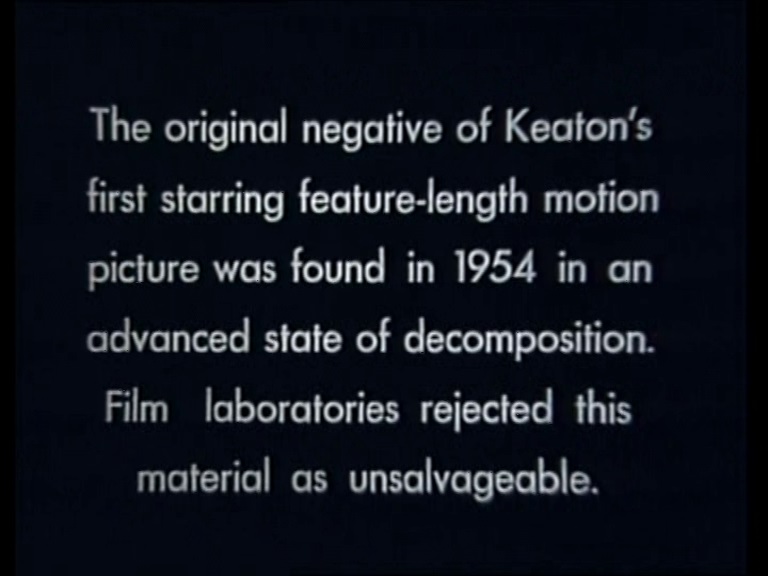 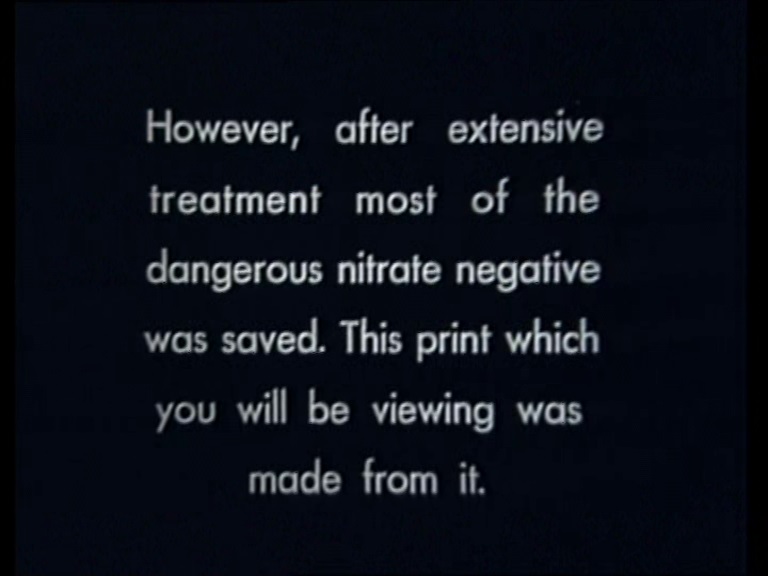 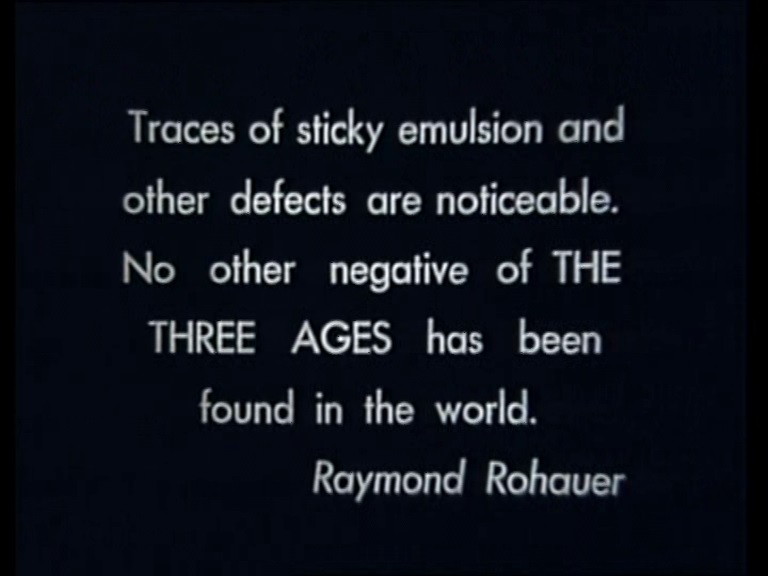 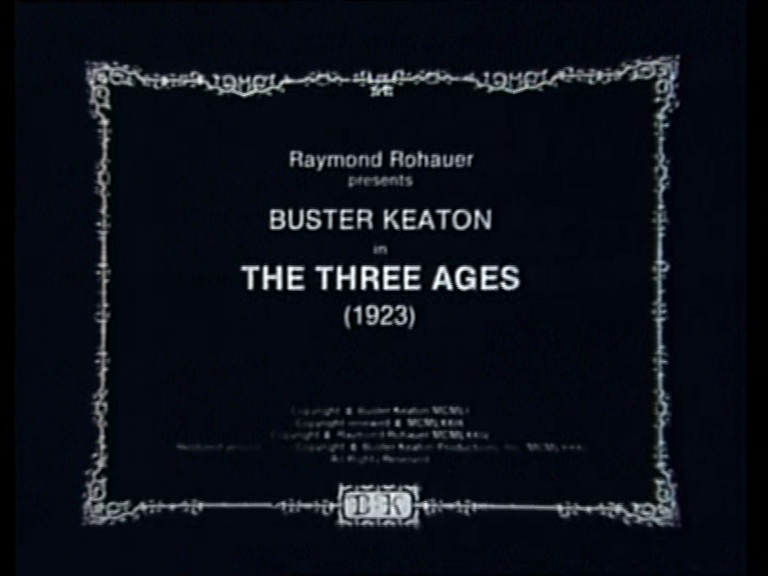 The copyright info is too blurry to read. Sorry. |
|
Are you confused?
If not, why not?
This could not have been a negative.
It could only have been a workprint or a preview print.
Yes? Yes? Yes? Yes? No?
|
|
We have physical evidence, though, that one more feature was in Buster’s garage:
an abridged rough cut of Hospitality.
Apparently, Rohauer ordered General Film Laboratories to run off a 16mm copy, I would guess a reversal.
Paul Gierucki discovered this print, though where and when and how I do not know.
He presented it to some Busterphiles and then Kino issued it on
|
|
Yet to Sidney Fields in 1970, Ray claimed that there was indeed a lot of film in Buster’s garage: ten features and four shorts!
So, which story is true?
Could it be simply that Fields garbled some of what Ray told him?
|
|
One more telling of the tale:
|
|
There we go again. Ten features and four shorts.
It’s beginning to look like Sidney Fields of the Daily News had not garbled Ray’s words after all.
Likewise, neither did Phil Thomas of the Associated Press.
Ray really did tell them that he had found ten features and four shorts in Buster’s garage.
It is not possible to square this with his 1981 claim to Don McGregor that there were fewer than that:
“A number of them, not a lot,” four or six features and probably two shorts.
My best guess, which is only a guess, is that Ray deliberately merged elements of two stories to make them seem like a single story.
He merged the story of Buster’s garage and the story of James Mason’s shed.
Why? Because the story of James Mason’s shed could be a touchy topic!
|
James Mason |
|
This is a terribly confusing story.
This story had not been confusing before.
The story, as I had understood it, was remarkably simple.
Here. Let me show you.
The first I knew about the story was from Rudi Blesh’s book on Keaton published by Macmillan on 16 May 1966.
This is how Rudi told the story (p. 368):
|
|
The Italian Villa had gone through many hands. Natalie Keaton
sold it in 1933. Fanchon and Marco lived there, Barbara Hutton,
a millionaire glass manufacturer, and, during a more recent period,
James and Pamela Mason. It was Mason who, in 1955, happened on
the secret panel to a film-storage vault behind the private projection
room of the Villa. There, untouched for twenty-two years, was a
cache of films — all of Keaton’s own features, from the first, The Three
Ages, to the last, Steamboat Bill, Jr., plus a good number of the shorts.
|
|
¿Simple story, que no?
Tom Dardis offered his own version (pp. 272–273):
|
|
Other Keaton films were found in the Italian villa, which
had passed through a number of hands after its purchase by Fanchon
and Marco. It was acquired in the fifties by the actor James
Mason and his wife Pamela. To his considerable surprise, Mason
discovered that the small projection room that Buster had used
to show films to his friends contained several dozen cans of film,
positive prints of high quality. It was this find, together with the
negatives and positives from MGM, which allowed for the eventual
rerelease of many of Keaton’s films....
|
|
Marion Meade also tried her hand at the same story (pp. 255–256):
|
|
Through the Italian Villa over the years had come and gone a
number of celebrities: the dance team of Fanchon and Marco,
Barbara Hutton and Cary Grant, Marlene Dietrich and Jean
Gabin, members of the Libby glass family. Just a few yards from
the main entrance stood Keaton’s tiny cutting room, where work
prints had been forgotten during his hasty exodus in 1932 and
whose original use remained unknown. Subsequent tenants and
their gardeners used it to store wheelbarrows and lawnmowers.
In 1949 the Italian Villa was purchased by James Mason, one
of England’s best-known movie stars. Seven years passed before
Mason and his wife got to poking around in their dirt-floored
toolshed and examining a rusting safe. It turned out to be
crammed with film. “We were horrified to find Keaton’s old films
rotting away in there,” said Pamela Mason. James Mason began
running his favorite Keatons until some of the sprocket holes
started snapping. At that point, he decided he must do something
about preservation, and he donated some of the Keaton films to
the Academy of Motion Picture Arts and Sciences.
Word of Mason’s treasure soon got back to Rohauer, who
urged Keaton to demand the return of the films. In fact, Keaton
did apparently turn up unannounced one day in spring 1956, his
first return to the Italian Villa in twenty-four years. The Masons
had changed the name of the street from Hartford Way to Pamela
Drive. They had also sold most of the land out of economic necessity,
and the property had been subdivided. The house that had
once overlooked a sweeping emerald lawn and robin’s egg-blue
swimming pool now looked over a row of ordinary backyards
belonging to ordinary Beverly Hills houses. When he rang the
bell, a maid informed him that Mason was not at home. Keaton
believed that he refused to show his face. “Mason wouldn’t come
to the door and the maid said I couldn’t get the film,” he told
New York Post reporter Jim Cook a few months later. He felt
humiliated and called his treatment “a crowning indignity.”
For James Mason, Keaton’s demand presented a dilemma.
Should he return the work or preserve it? Eventually he decided
that Keaton did not possess the facilities for preservation and
could never derive any financial advantage from having his films
anyway. He chose the Academy, but Rohauer subsequently persuaded AMPAS to return the films to Keaton.
Accompanied by Rudi Blesh, Keaton returned to the Villa for
films not given to AMPAS. Inside the house he found alterations
even more striking than those made to the grounds. Exquisite
chandeliers had been replaced. For the Mason children, the original
Oriental carpets had been removed and the marble and oakwood
floors covered with cork. There was also acoustical tile lining
the ceiling of the drawing room, which Pamela Mason used to
broadcast a radio show. Dozens of cats roamed freely through the
house.
At home, Keaton carried the film cans into the kitchen and
unpacked the nitrates as nonchalantly as a bag of groceries. There
was a cutting copy of The General, as well as a number of Keaton’s
earlier shorts, including the only print of The Boat that would ever
be found. As it turned out, The Boat was almost beyond redemption.
Once he had screened the pictures, he turned them over to
Raymond for transfer to safety stock.
Shortly afterward Keaton phoned the Masons to ask if he
might bring his wife around to visit. Pamela Mason, embarrassed
about the alterations she had made, refused. “I ruined his beautiful
house,” she said. “But I was young and didn’t understand that
the place was historical. I was afraid — what if he had told his wife
about his grand house and then she walked in and saw the cork. It
would have broken his heart.” Keaton did not ask a second time.
|
|
Probs probs probs.
Marion Meade invented so much of that narrative out of whole cloth.
Buster never got inside the house.
“James Mason began running his favorite Keatons until some of the sprocket holes started snapping.”
Rubbish!
James did not run or watch the nitrate prints.
We shall discern later how he and Pamela managed to watch the films, but they did NOT watch the nitrate prints!
All the films had been turned over to AMPAS,
and so Buster absolutely did NOT return a second time to collect the films that still remained behind.
Marion Meade just made all that stuff up.
Repeat: MARION MEADE JUST MADE ALL THAT STUFF UP.
|
|
I find it rather distressing that film historians and film professors for the most part
have not a clue what is required to shoot a film,
or record it, or edit it, or mix it, or time it, or print it.
For now, because Marion Meade mentioned projection and snapping sprocket holes,
let us learn a little bit about projecting motion picture film.
Below is a video that runs some 17 minutes showing Tim O’Neill at work at the
Gateway Theatre in Chicago.
Please watch it all the way through:
|
|
filmteknik, The Last Carbon Arc Projectionist in Chicago, posted on Nov 16, 2011. When YouTube disappears this video, download it. |
|
Looks totally intimidating, doesn’t it?
Well, honestly, it’s not hard work.
Almost anybody could learn the basics of the job in a few days.
If you’re not trained, though, you can see that you wouldn’t know what on earth to do,
you wouldn’t know even which switch does what.
You would be totally clueless.
|
|
Buster’s villa, because it was Buster’s, included a screening room.
As a matter of fact, when Pamela and James moved in, Buster’s projectors were still there.
They were smaller machines that would not be used in a cinema,
but that would instead be used in a small screening room or in a military situation.
They did not have carbon arc but 1000W Mazda bulbs.
They were Simplex Acme, first put on the market in
1931, and Buster purchased them not long before he left the villa forever.
(Thanks to Richard Adkins and Bill Counter for the research on these machines!)
Now, let us interrupt the narrative to look at Buster’s projectors.
|
|
fernando, Proyectora de cine simplex acme 1939, posted on Dec 10, 2018. When YouTube disappears this video, download it. This is a somewhat later model. I am thrilled that I finally get to see the gear mechanism! Oooooooooooooooooooooooooooo! Beautiful design! That is the sort of design, I think, that, if we never service it, never open it, never adjust it, it should last 20,000 years and continue to run flawlessly. I need to save me pennies and get me a couple of these contraptions. |
|
So, Buster had a booth and a screening room,
and the booth was surely rated to contain fires and explosions.
Okay. Fine.
Could Pamela and James have operated these machines?
Most likely, since they were so simplified and already installed.
There’s still a major problem.
|
|
The films were nitrate, yes.
As Pamela assured Marion Meade (see below), everybody ran nitrate film at home in those days.
Yet these particular prints were not just nitrate.
They were between about 25 and 35 years old,
decayed and brittle from having been exposed to high and low temperatures, high and low humidity.
Running such physically compromised films would have posed a
lethal risk of fire, and the Masons knew that.
Suppose, for the sake of argument, that the Masons did not know that.
It would therefore follow that they did not know how to operate 35mm projectors,
and so they would have needed to hire a projectionist to go to their house and entertain them.
As a matter of fact, as Pamela explained to Marion Meade,
Hollywood folks hired projectionists to show movies at home.
Now, watch this video of some portable machines running a new — new, NEW! —
nitrate print in good condition:
|
|
HuntleyFilmArchives, Nitrate Film Handling, 1940’s - Film 6416, posted on Sep 15, 2014 When YouTube disappears this video, download it. |
|
Did you watch that video?
Did you watch it all the way through?
Good.
Would you hire a projectionist to run brittle and degraded nitrate films in your house?
Even if the projectors were placed inside a fireproof concrete booth with explosion vents?
No projectionist anywhere on the planet would have projected those films.
Upon attempting to wind those cores onto reels, even the most uneducated, foolish, suicidal projectionist would have said,
“It’s too far gone.
I ain’t touchin’ this stuff.
You need to get it copied if you want to see it.”
Not even viewing those prints on a
flatbed editor would have been a good idea.
So, were Pamela and James foolish enough to lace up badly compromised 30-year-old nitrate prints
and project them in their home?
No way. Absolutely not. They didn’t do such a thing.
They didn’t even think about doing such a thing.
We can say that not as a probability, but as an absolute certainty.
Besides, Pamela assured Marion Meade that they never used Buster’s projectors.
|
|
Now let us examine an article that Olga found in the September 1960 issue of
Amateur Cine World. I had never heard of that magazine. Had you?
She sent me a poor scan that she seems to have found online somewhere.
That got me curious, and so, like the maniac I am, I scoured the Internet for a used copy.
And I found one. But to buy it, I would need to buy a whole collection.
So I bought the whole collection.
Why did I spend that money?
It makes no sense. I make no sense.
Here it is:
|

|
|
That story seems so straightforward, does it not?
Well, to most people it would seem straightforward.
As for me, I find it incomprehensible as written.
How did James Mason discover the hidden vault?
After a quarter of a century of exposure to the elements, these prints were no longer projectable.
Thought experiment: Suppose you leave your album of family photos in a concrete bunker
with no heating or cooling for
|
|
Pamela Mason explained things to Marion Meade, but her comments never made it into Meade’s book.
Here is a passage that Olga shared with me.
It is from the
Marion Meade Buster Keaton Research Files at the University of Iowa:
|
|
Many people had lived here after Buster Keaton, and
none of them had bothered to open the vault. Because
people like Cary Grant obviously didn’t care, and they
probably ran through as we did when we were in this
shed. Those days they had to hire a projectionist, and
they had 35-millimeter projectors. Which we do, we
still have, but we never used them. Now, of course,
we don’t, but in those days, everybody ran movies. But
I think that it’s strange that all these people had lived
here, and people like the gardener had never looked to
see what was in the vault.
But what happened was when we came in, in the garden shed, there was a vault.
And when we finally got the vault open, all of Buster Keaton’s old films were in it, rotting away.
And we were appalled, horrified, at that time nobody knew [who] Buster Keaton was....
And so James got on to the filmmakers and said, can you do anything to save these films if we send them over to you?
Would you stretch them and oil them or stuff you have to do to take care of the old films?
And take care of it, which James said they would do, and they did.
And we asked them if we could have a copy of two of them.
I think we had two copies of one and one of the other.
And the one that we had to take a copy of was for Rex Harrison who wanted it, so we gave it to him.
|
|
The above passage illustrates why I hate to interview people.
Few people know how to talk.
After people (especially professors) get through explaining something,
I understand less than I did before the conversation began.
“When we came in... there was a vault.”
And when you didn’t come in, there wasn’t a vault?
The vault was hidden.
So who noticed the vault, and how?
The Masons purchased the house in January 1949,
and so what prompted the discovery of the vault in the spring of 1955?
“And so James got on to the filmmakers....”
Got on to? Does that mean contacted? The filmmakers? Which filmmakers?
I presume that “filmmakers” here refers to
the heads of the film archive at the Academy of Motion Picture Arts and Sciences (AMPAS),
who were not exactly filmmakers.
If so, that would have occurred towards the end of 1955, I think, probably.
“Stretch them and oil them”? Huh?
The prints needed to be taken to a lab, inspected, cleaned, and repaired,
and then the technicians would need to generate new preservation negatives.
“A copy of two of them”? Which two?
One was certainly The Play House,
and that was probably the one that was printed a second time for Rex Harrison.
What was the other film?
I bet the two copies of one film and the one copy of the second film were 16mm.
After all, Pamela in the quote above seems to say
that Hollywood families no longer projected 35mm films at home.
|
|
Insider, How Old Movies Are Professionally Restored | Movies Insider, posted on Feb 17, 2022 When YouTube disappears this video, download it. |
|
Despite the problems with the ragged narrative, we can learn a little from Pamela.
We learn that she and her husband never used Buster’s projectors.
We do not learn how they viewed the films.
So, how did they view the films?
And when?
There are only two possible explanations.
One possibility is that as General Film Laboratories ran off each new 16mm print, James and Pamela asked for a viewing.
Another possibility is that when they donated the films to AMPAS
they requested screenings once new triacetate copies were ready.
|
|
Shall we attempt further to sensify this tale?
Yes! Let’s!
Olga referred me to Kevin Brownlow’s book, Alla ricerca di Buster Keaton
(Cineteca Bologna, 2009), page 26.
Kevin interviewed Rudi Blesh, who had some amazing things to say:
|
|
It was difficult to see any of Buster’s films when I was writing the book.
A lot turned up in Czechoslovakia, and prints were made. I can’t remember
who located them, but Rohauer was responsible for making copies. Buster said
that all his films were left under the staircase in a secret hiding place in the
Italian Villa, if you can get in to look at them. I called James Mason and he
said that Buster Keaton was not welcome in his house. This was amazing.
But he would have the films put in the garage
and we could project them. James Mason told me that himself. We took them
someplace where we rented a projector, and they were constantly breaking
because they were old and brittle. After we viewed them they went back to
Mason. Buster liked the name of the street that ran up to his house — Cinema
Drive — and when James Mason bought the house he renamed the street after
his wife: Pamela Drive.
|
|
So, does that make you less confused?
Or more confused?
Oh, there is so much to decipher in the above passage.
To my knowledge, the street was never named Cinema Drive.
The house was at
1004 Hartford Way.
It was on a little branch that jutted out from the main part of Hartford Way.
It was only that little jutting branch that James petitioned to be renamed Pamela Drive.
|
|
Why would James Mason not allow Buster in the house?
The reason was simple: Pamela was ashamed of what she had done to the house.
In one of the rare passages in Marion Meade’s book that seems credible,
and which we already saw above, we hear from Pamela (page 256):
|
|
I ruined his beautiful
house. But I was young and didn’t understand that
the place was historical. I was afraid — what if he had told his wife
about his grand house and then she walked in and saw the cork. It
would have broken his heart.
|
|
Who located the films in Czechoslovakia?
Most likely Henri Langlois or someone on his staff or a Czechoslovakian colleague at his urging.
The films in the Masons’ house were not under the staircase, but hidden behind a false shelving wall in the garden shed.
Since Rudi never saw the garden shed, he can be forgiven for misremembering that detail.
Buster did not have all his films there;
he had only seven of his shorts but he did have all ten of his features
from Three Ages through Steamboat Bill, Jr.
|
|
I bet that James Mason had no clue about the secret film vault until Rudi contacted him.
Buster told Rudi about the false shelving wall in the garden shed and the dial-lock bank-vault door behind it.
And, no, sorry, he couldn’t remember the combination.
Upon hearing about that from Rudi,
James must have gone into the garden shed and discovered that,
yes, the shelving wall was false and could be swung away.
And, yes, behind it was a bank-vault door with a dial lock.
He hired some locksmiths to drill out the lock and, lo and behold, the story was true.
Films were inside!
|
|
Jim Curtis (pp. 575–578) explains that the abandoned editing bunker contained only seven short films.
According to Matthew Bilodeau,
“Buster Keaton Had to Do Some Digging to Rescue His Early Films,”
/Film, 3 September 2022, the seven shorts were
The Play House,
The Blacksmith (early preview print),
The Boat,
The Paleface,
Cops,
My Wife’s Relations, and
The Balloonatic.
As for the feature films, Curtis explains that only
Battling Butler,
The General (final preview print),
College, and
Steamboat Bill, Jr.,
were complete and usable.
Our Hospitality,
Sherlock Jr., and
The Navigator had partly disintegrated.
Three Ages,
Go West, and
Seven Chances were “total losses,”
though precisely what “total losses” means here, I do not know.
Tally those feature titles and the total is
10,
even though on page 577 he wrote that
“Inside were nine of the ten
features Keaton made for Joe Schenck....”
(We see on the following page that he neglected to count Our Hospitality,
which did not arrive at the Academy until slightly later.)
There was one further Buster film there, too, a dreary MGM flick called
Parlor, Bedroom and Bath, a few scenes of which had been filmed on the villa grounds.
|
|
Note that Three Ages was in the bunker.
Jim Curtis referred to the print as a total loss,
but does it mean that each reel had disintegrated into a heap of explosive brown powder?
Or does it mean that so much of the film was damaged that an attempted rescue was not worth the effort or cost?
Think back to Ray Rohauer’s statement to Kevin Brownlow that he had been able to rescue only four of the six reels
of the print in Buster’s garage, and that he then “got additional material to replace those missing reels.”
Was it James Mason’s bunker that supplied that “additional material”?
My guess is that, yes, that was the source.
If my guess is correct, that is further evidence that Ray tended to combine the story of Buster’s garage
with the story of James’s bunker when he spoke with journalists.
So many ifs here.
In reconstructing the story, we need to keep repeating if if if if if.
There is so much we do not know.
The few people who knew the details did not find them interesting
and had no premonition that we, seven decades later, would crave all these details.
Without these details, we can never reconstruct precisely what happened.
|
|
To add to the contradictory sources, we can refer to Ed Watz, who was in the know.
He posted a comment at NitrateVille on
23 August 2023, which reads, in part:
|
|
The introductory screen notes before the film state that
“two existing original camera negatives” were used in this restoration.
This contradicts what Cohen/Eureka previously wrote in their press release.
There is no original existing camera negative to THREE AGES.
Although it was a Metro release owned by Joe Schenck,
MGM held and later junked the THREE AGES prints and negatives held in their vaults sometime prior to 1951.
Buster’s own original print of THREE AGES,
found by James Mason in the vault on the Italian Villa property in the
The final shot of Buster, his wife and their small dog leaving their duplex
was so badly decomposed in Rohauer’s 1970s release version
that in 1982 he substituted the final shot from a bootlegged Russian print discovered in the late ’70s.
While that footage is dupey-looking and contains a couple of splices,
it’s certainly a vast improvement over not being able to clearly see the fadeout joke.
|
|
James Mason left the films in the garage for Buster and Rudi to pick up and carry away to project and then return?
Whoah!
Was James really that reckless?
Did he really not understand the danger of projecting old film that had been attacked by the elements?
He was not that reckless.
He understood the danger perfectly well.
Yet Buster and Rudi took them to a place where they could rent time to watch them?????
Pause. Stop. Think. Review. Ponder Rudi’s literary device, explored earlier.
Look again at a sentence he uttered:
“We took them someplace where we rented a projector, and they were constantly breaking because they were old and brittle.”
When you read that sentence, you think that Rudi stated that he and Buster drove the films
to a service where they could plop the sticky shrunken corroded brittle broken rolls onto split reels and run them on a projector,
and that the films frequently snapped as they were running.
That is not what Rudi said at all!
Read the sentence again.
Each part of it was true, or somewhat true, but the parts were not connected in the implied way.
|
|
Rudi said they projected the films.
If they were projected, then Buster, Rudi, and the personnel of the service they used were beyond foolhardy.
They were lucky to get through the exercise alive.
Buster was fully aware of the dangers of decomposed nitrate,
and he and Rudi and the technician must have noticed, when they opened the cans, that a number of the reels,
and some entire films, had disintegrated.
Buster liked to take chances, but he never knowingly risked his life.
We can be certain that James, Rudi, and Buster had no intention of projecting the films.
They surely did not even consider viewing the films on a Steenbeck
or on a
|
|
“We took them someplace
where we rented a projector,
and they were constantly breaking because they were old and brittle.”
|
|
Okay, hold on.
Rudi said “someplace”?
Why did he say “someplace”?
Why didn’t he say where?
He kept some things on the QT, and for good reason.
He was protecting Ray Rohauer.
That is why he was so vague.
Let us reason this through.
Buster at the time did not have regular employment.
He was constantly appearing on stage and on television guest spots in those years.
His longterm contract with MGM had run out, his
|
|
Now to explain where they watched the films.
“Someplace” was actually “someplaces.”
Not only was “someplace” General Film Laboratories,
“someplace” was also the Coronet Theatre!
Why on earth would Ray need to rent a projector to watch the prints as they emerged from the lab?
He drove each print down to the Coronet, plopped it onto his little 16mm machine, and gave it a whirl.
Ray watched from the booth and Buster and Rudi got a private show in the auditorium.
That’s what happened.
Ray would then choose some of the public-domain films (not the copyrighted films) to show to paying audiences,
likely only to his members-only audiences, and he may well have invited Buster and Rudi to attend.
|
|
Another question arises:
When did Rudi and Buster contact James Mason?
When did they start borrowing the films?
MoMA ran the Buster movies at BAM on 12 March 1952,
and so that puts an extreme limit on the chronology.
Rudi did not meet Buster until 6 October 1953, and that was in NYC.
Buster was not back home in LÁ until at least a few days afterwards.
So the earliest that Rudi could have contacted James Mason was
|
|
The Masons’ house in Beverly Hills is Spanish style, in white and blue. It
was built by Buster Keaton who still returns occasionally to borrow or return one
of his films which are stored in a vault there. The only other memento he left was
an enormous living-room fireplace, flanked by two naked pink plaster ladies who
held up the mantel. Recently the Masons decided to dispense with them and they
were torn out with hammer and chisel.
|
|
Okay. So Buster and Rudi didn’t pile all the films into the car at once.
They borrowed one film at a time.
That much is settled.
The above quote from Elspeth Cochrane leaves us with the conclusion
that the latest possible initial contact between Rudi and James was June 1955.
We learn from Jim Curtis’s book (page 577) that James Mason donated the films to AMPAS in January 1956.
That is why I tend to place the likely first contact as closer to June 1955.
As a matter of fact, Olga goes one better and gets even closer to the actual date:
|
|
If we turn to Keaton’s interview with Jim Cook
(New York Post, Sep. 11, 1956), he says there that he first tried to get into the Villa “last spring” and
failed — so, for lack of a better info, I’m going to assume for now that Buster was not wrong about the
timing and the first time he actually showed up at the Villa was in the spring of 1955.
|
|
As I was reading Olga’s extensive message,
which could easily be published as an article in a scholarly film journal,
I was trembling with excitement.
Step by step, she was solving the mysteries that had been giving me migraines for several years!
I had eventually worked out a hypothesis that seemed plausible,
and I included my plausible hypothesis in earlier versions of this website,
but my guesses were all wrong, totally, totally wrong.
|
|
Now that Olga has brought up Jim Cook, let us look at his article.
First, though, let us look at two companion articles,
one by Hedda Hopper and one by Joe Hyams.
|
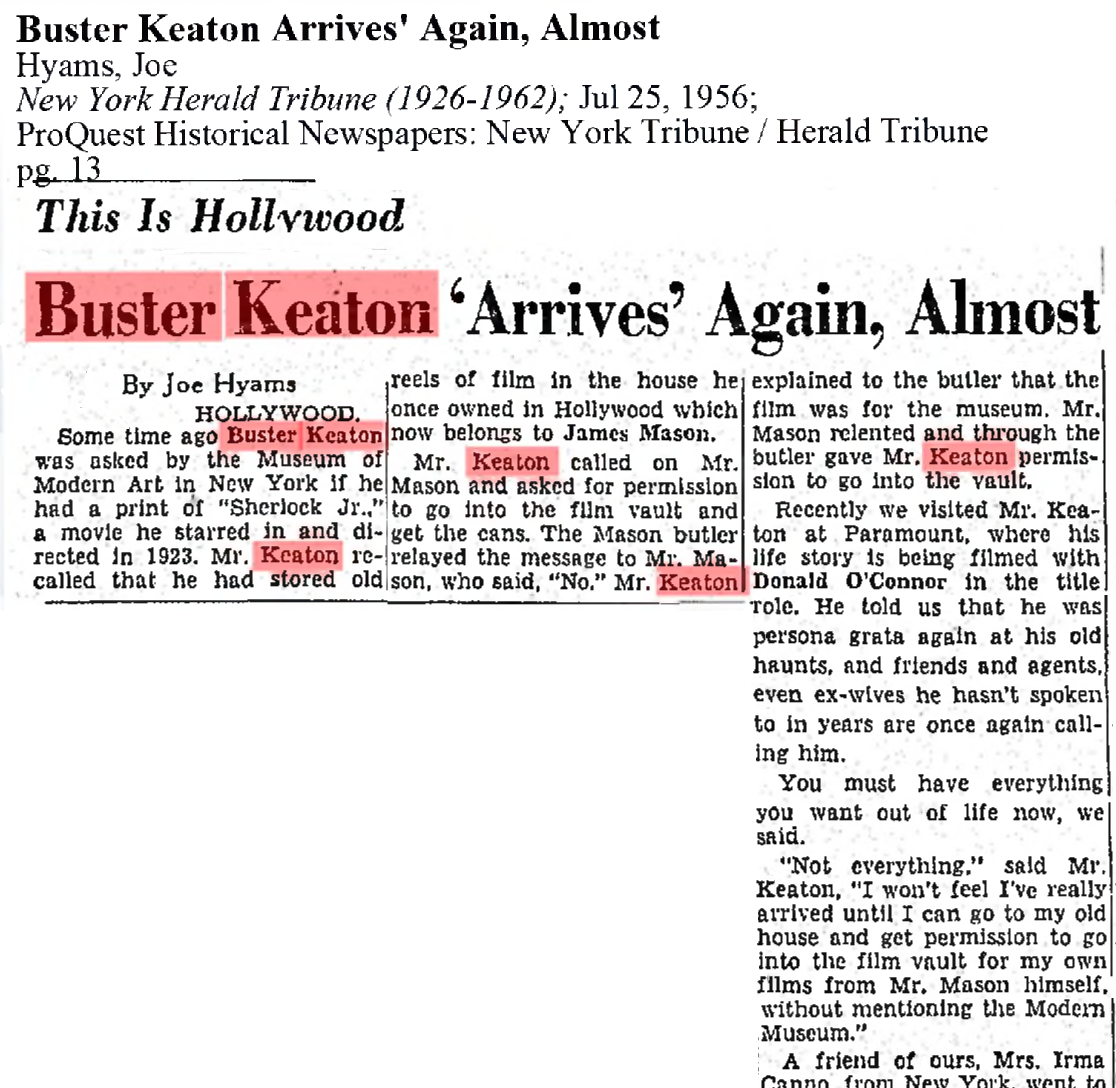 Thanks to Olga Egorova for locating this article for me! |
|
Can it get any better than this?
It sure can!
Olga reminded me of a passage in the interview that Eleanor gave to Marion Meade,
quoted above — quoted twice above!
It is a passage of cosmic importance that Meade decided was not worthy of her book.
Let us take yet a third look and ponder another detail:
|
|
That started that. Then he [Ray] went from our original six or eight films, whatever it was we had,
it started... Then he found... James Mason called Buster and said, “I’ve just got into the... You
want them? I’m going to get rid of them. I want them out of there, because they’re old nitrate.
They could explode.” So Buster, at that time, called... I think Rudi Blesh was out working on the
book at that time, and the two of them went up and retrieved all the films and brought them back
and viewed them and gave them to Raymond to be cleaned up and transferred to safety stock
and whatever. That gave Raymond a few more.
|
|
Clearly, Eleanor was not directly involved in these events and so her memory was a bit compromised.
She probably postulated ways to fill in the gaps and then thought that her imagination was true memory.
We all do that. No big deal.
Yet, as Olga urges, we should not discount Eleanor’s story, for it otherwise fits all too well!
It is easy for us, now, to figure out that James called Buster to say not that he discovered the vault,
but that, thanks to Buster’s story, he was able to get in.
Yes, James wanted the films out of the house, but not to give them to Buster.
He would hold onto them long enough to have an accountant assess their tax value for purposes of a charitable donation.
He would then donate them to a museum.
In the meantime, Buster and Rudi could borrow them one by one.
They did not view the films and then hand them to Raymond.
It was the other way around!
|
|
Importantly, however compromised Eleanor’s memories of this episode may have been,
there is one element of it that she could not possibly have mixed up:
By no later than the spring of 1955, Buster and Ray were already working together!
So that settles that. Definitively.
Jim Curtis’s reconstruction, which puts the first meeting of Ray and Buster at about September 1958, now falls apart.
It will continue to fall further apart.
Eventually, we shall examine Jim’s evidence, piece by piece.
We shall never discover every detail,
but we shall learn enough to come to a reasonable understanding of what actually transpired.
|
|
Oh I can’t help myself.
Let me quote directly from Olga’s message:
|
|
First, Eleanor definitely states that Mason’s films were found after Buster’s meeting with Rohauer
(which matches Rohauer’s version of events and to me indicates that his 1954 story is not such a lie —
it never seemed to me that Eleanor had lost her mind with age, or was prone to lying — especially
since Rohauer had been dead for several years by this time). Second, she correctly remembers
that Buster went to the Villa with Blesh, and that they eventually managed to get the movies — she just
doesn’t remember that they didn’t get all the movies at once and forever. This is not surprising, since
she hardly ever dealt with films directly anyway; but what she did know was that the films went to
Rohauer, who “transferred them to safety stock,” or, simply put, copied them. Of course, she
could have been mistaken and confused with the endless copying of movies afterward; but if Ray was
really in the game by this time, I’d be surprised if he missed such an opportunity.
|
|
At long last, we are beginning to make sense of what had previously seemed senseless.
|
|
There is another version of the Mason/Keaton story.
Open the Jim Curtis book and turn to page 577.
|
|
James Mason, who would later claim he was out of town when Keaton
appeared at his door, apparently summoned a locksmith to open the vault.
Inside were nine of the ten
features Keaton made for Joe Schenck, and seven
of his best
“A dilemma presented itself,” he wrote. “Should I make a respectful
humane gesture towards the great artist? Or should I guarantee the preservation
of the films? I knew that Keaton could not use the films to his
personal advantage and that he did not command the facilities for preserving
them. Anyway, right or wrong, I chose [to donate the films to] the
Academy.” And so in January 1956, the Academy of Motion Picture Arts
and Sciences took delivery of the entire contents of Buster Keaton’s former
vault, which included 35mm prints of The General, The Navigator, Three Ages,
Go West, Cops, The Boat, and Sherlock Jr. For his trouble, Mason awarded
himself a $10,000 deduction on his federal income taxes.
|
|
Where does the above story come from?
We turn to the endnotes and our collective heart sinks.
It comes from Raymond Rohauer, “Buster Keaton and the Race against
Time, or Where Have All the Comedians Gone?” Notes for the National Film Theatre
of London, 1968.
That puts us at least two removes from the source of Mason’s quote.
A Google search reveals that this essay is freely available
online, but in almost illegible quality.
Five pages of relentless blur.
So I retyped it for you. Aren’t I nice?
Irony: I didn’t need to!
The Pacific Film Archive just rescanned it at higher quality.
So here goes, the PFA’s new scan:
|
|
|
|
You surely noticed the content and style and argumentation of the above piece.
It should not require a Ph.D. in psychology to determine from his brief essay that Ray had a character disturbance.
Now, Ray told countless fibs in his time, and some of those fibs are indeed in the above piece,
but the letter from James Mason is surely authentic.
The style and grammar have all the hallmarks of James Mason’s erudition,
and that was not something that Ray would have been able to fake if his life depended upon it.
|
|
Character disturbance?
I don’t think I’m being too extreme by expressing it thus.
Let me illustrate by juxtaposing some quotations and data.
We can start by looking at what Ray said to Don McGregor in the pamphlet called Buster: The Early Years
(Staten Island, NY: Eclipse Enterprises, 1982), page 28:
“my father passed away when I was a baby.”
That is a simple enough statement, perfectly true so far as I know.
Ray’s claim sort of matches what Eleanor told Marion Meade
in the unpublished interview quoted above:
“Raymond’s parents were killed when he’s not too old....”
Actually, Ray lived with his mother, Rose Mary Fiebelkorn, and took her with him to Los Ángeles.
Her native language was German, which is why I strongly suspect that Ray was a fluent German speaker.
She passed away in 1952, when Ray was 28.
The records on
Ancestry.com suggest that Ray’s dad was gone prior to the 1930 census
and suggest further that his mommy and daddy had never tied the knot.
Yet for the
1930 census Rose declared herself widowed.
The Buffalo Courier vol. 90 no. 353 of
Saturday, 19 December 1925, page 3,
published a two-paragraph article entitled
“Identify Victim of Gas Fumes,”
which told of a “William J. Rohauer, twenty-one years old, No. 2599 Fulton street,”
who had passed away two nights previously when he “was overcome by fumes of a gas stove.”
Actually, that was a misprint.
He lived at
259 Fulton Street and he was probably 25 years old, not 21.
I cannot be certain, but I strongly suspect that this William J. Rohauer was Ray’s daddy.
William was some seven or eleven years younger than Rose, but then Rose’s other child, Kenneth,
who was also born out of wedlock, was sired by Theodore Robert Alexander Engelhardt, who was some eight years Rose’s junior.
Younger guys seemed to be her preference.
Rose never married, and so Ray never had a
Then we get to Kevin Brownlow’s book, Alla ricerca di Buster Keaton (Cineteca Bologna, 2009), page 244:
“It was such a great part of my life that when
Buster died it was like missing a member of my own family. There’s a certain
closeness that occurs between people when they work together and travel
together, and my personal relations with him have always been great. I think in
my own way I loved him. That I never felt for anyone else. Not even my own
father.”
Need I say more?
|
|
Do we have confirmation that Mason donated the films to the Academy
and did not hand them over to Buster?
Look at Jim Curtis’s book, pages 611 and 612,
and there is sufficient detail to convince any doubters.
Nonetheless, I shall eventually find the original documentation.
I am certain it still exists.
|
|
There is another version of the Mason/Keaton story:
|
|
Keith Scott, The Moose That Roared: The Story of Jay Ward, Bill Scott, a Flying Squirrel, and a Talking Moose
(NY: St. Martin’s Press, November 2001), pp. 226–227:
In 1954, while managing the Society of Cinema Arts in Los Ángeles,
Rohauer was contacted by actor James Mason, who had bought Buster Keaton’s
house. Mason had discovered a gold mine of valuable film stored in
the basement. This was Keaton’s personal collection....
|
|
You have now read how many different editions of this story?
They all contradict, and not in minor ways, but in essentials.
Each is incompatible with all the others.
Which one is right?
What really happened?
Some of these stories contain some of the truth.
Olga has done yeoman’s work in harmonizing the various accounts
and reading between the lines, as you could see above.
Most of the contradictions are now resolved.
Most of them.
Not all of them.
|
|
Let us now examine the most important of the remaining contradictions.
|
|
HEDDA HOPPER:
“...I went to get them and I couldn’t get in to see Mr. Mason
nor could I get the films. But the Modern Arts association requested them and got them out.”
|
|
JOE HYAMS:
Some time ago Buster Keaton
was asked by the Museum of
Modern Art in New York if he
had a print of “Sherlock Jr.,”
a movie he starred in and directed
in 1923. Mr. Keaton recalled
that he had stored old
reels of film in his house he
once owned in Hollywood which
now belongs to James Mason.
Mr. Keaton called on Mr.
Mason and asked for permission
to go into the film vault and
get the cans. The Mason butler
relayed the message to Mr. Mason,
who said “No.” Mr. Keaton
explained to the butler that the
film was for the museum. Mr.
Mason relented and through the
butler gave Mr. Keaton permission
to go into the vault....
“I won’t feel I’ve really
arrived until I can go to my old
house and get permission to go
into the film vault for my own
films from Mr. Mason himself,
without mentioning the Modern
Museum.”
|
|
JIM COOK:
“...the crowning indignity came
when I went to the house last
spring to get one of my old films
which was still in the vault there.
Mason wouldn’t come to the
door and the maid said I couldn’t
get the film. But I played a trump
card — I told her to tell Mason
that the Museum of Modern Art
in New York wanted it. I got it
then.”
|
|
The Museum of Modern Art already had a 35mm lavender of Sherlock Jr. as well as at least one 16mm print.
Why would it need an old print from Buster?
Then we have another question.
The “butler” in one interview becomes the “maid” in the following interview.
Why? Buster did not change his story.
One of the journalists got mixed up.
James Mason had taken a call from Rudi Blesh and thus discovered the vault.
So how does the story evolve into Buster arriving at the door only to be turned away
until he mentions the Museum of Modern Art?
Was it the Museum that got the film out,
or was it James Mason who relented and granted Buster permission upon hearing about the Museum?
None of this makes sense.
Something went wrong in the transmission of this tale;
it was as though this was a round of the Telephone Game.
Jim Curtis, in a footnote on page 577,
explains that when James Mason’s donation first reached AMPAS,
Our Hospitality was missing, but that it appeared shortly thereafter.
He therefore supposes that the story about MoMA asking for Sherlock Jr.
was a garbling of the request for Our Hospitality.
If so, that might make sense, since MoMA did not have preprint material on that film, but only a nitrate print.
On the other hand, James Mason did not have preprint material on it either; he had only a nitrate preview print,
and, if we are to judge based on what Jim Curtis quoted on pages 611–612; it had rotted beyond usability.
Why did MoMA want it or need it?
I am totally confused.
|
|
Olga referred me to the following article:
|
|
On the basis of the above article,
Jim Curtis concluded that the “butler” mentioned by Joe Hyams
who became the “maid” mentioned by Jim Cook
was actually Kenneth Tynan.
See page 743, note to page 576.
Say what?
Kenneth was referring to an entirely different event,
one that surely predated the request to get into the vault,
predated it probably by a few months.
Buster in about November or December 1953 probably really did want to show Eleanor the old Villa.
Actually, I bet his real goal was to show the Villa to Rudi, for his book!
He probably did not mention Rudi to the gentleman who answered the door, because that would seem just a bit too odd.
Instead, he mentioned his wife, who had never seen the house.
Should the Masons prove receptive, Buster would have brought both Eleanor and a friend, namely, Rudi.
That, I think, was the purpose of Buster’s request.
He rang the bell and Kenneth Tynan turned down his request.
Buster then gave up.
Rudi and Eleanor probably never learned about Buster’s request to the Masons.
|
|
Now, think back to that passage in Kevin Brownlow’s book, Alla ricerca di Buster Keaton,
in which Rudi Blesh explains,
“Buster said that all his films were left under the staircase in a secret hiding place in the Italian Villa,
if you can get in to look at them.
I called James Mason and he said that Buster Keaton was not welcome in his house.
This was amazing.
But he would have the films put in the garage and we could project them.
James Mason told me that himself.”
That did not make much sense when you first read it, but does it make sense now?
Buster had asked if he could bring Eleanor over to look at the house,
and Kenneth Tynan, on Pamela Mason’s authority, said No.
Just afterwards, Rudi asked if there were any further films to view,
and Buster mentioned a collection that may still be at James Mason’s house,
but, knowing that he was not welcome there, he did not want to ask.
Rudi could try it, though, “if you can get in to look at them.”
It was Rudi who then phoned James Mason, who, remembering Buster’s recent attempt to visit,
made it clear that Buster was under no circumstances to enter the house.
He agreed, though, to leave the films in the garage for Buster and Rudi to pick up.
|
|
Now it is time to quote from Carl Hultberg again.
We read on page 69:
|
|
One of the big problems for Rudi the biographer was actually
getting to see Keaton’s old films. He’d seen some of them thirty
years earlier but what could he remember? What could Buster
remember for that matter? But in this case, Buster had a plan.
His old mansion in Hollywood had a secret room which contained
copies of his old films. He and Rohauer would go to visit and
recover the films. So they went. They rang the bell and the man
who answered was new owner James Mason. “And what can I do
for you... Buster?” was his supercilious greeting. Dubious at first
Mason then let Buster and Rohauer in. Sure enough under the
stair opened by pushing a secret switch a small room appeared
filled with film cans. “Well thank you very much gentlemen”
Mason replied ushering them out the door. Mason later made up
a story about finding the films “after a renovation”. A period of
negotiations followed the upshot of which was that Rudi got the
chance to sit through one long continuous viewing of the various
films. This in the end, in the dark theatre, led to some confusion
between movie plots which crept into Rudi’s notes and narrative,
making it easy for hotshot 1960s/1970s writers to take potshots at
KEATON, the book, once the movies went back into some sort of
limited distribution.
|
|
See how stories get so garbled?
|
|
It’s time to ponder something for a few moments.
As far as I know, Buster and Natalie moved into the Italian Villa at the end of 1926,
and so the only films Buster would have edited in that secret bunker were
College and Steamboat Bill, Jr.
The previous films he had edited, I suppose, in the studio.
|
|
Are you wondering what I’m wondering?
Normal practice has always been to edit films at the studio.
It was never standard practice to take the rushes and/or preliminary assemblies home to edit.
It was certainly not standard practice to perform this task inside a hidden subterranean concrete bunker,
locked closed with a safe door which in turn is hidden behind a false shelving wall in a gardening shed.
So, are you wondering what I’m wondering?
UA hated Buster almost from Day One and immediately sought to strip him of control of his films.
Buster was now protecting himself.
He did not want Joe Schenck or anybody from United Artists entering his editing room
to make alterations to his pictures, to make deletions, additions, revisions, or reinstatements.
He didn’t want to have any business suits breathing down his neck as he was sculpting his movies into shape.
|
|
The print of The General that Buster filed away in his secret editing vault was a preview print,
certainly the print shown at the Alex in Glendale in November 1926.
The print of The Blacksmith was also a preview print, but not the final preview print.
It was an earlier rejected edition of the film.
That is why I assume that everything in that hidden concrete bunker was a preview print, and not necessarily the final preview print.
(Meade, in one of her rare statements that is likely correct, wrote on p. 408, note to 256, that
“BK films in the cutting room shed were working copies, not release prints ready for distribution to theaters.”)
As far as I can make out, Sherman Kell would be at the studio,
putting together a preliminary assembly day by day as Buster was shooting.
Upon completion of shooting, Buster would take Sherman’s preliminary assembly to his home to edit.
Sherman was by his side, madly trying to keep pace with him,
pulling the material he requested and winding the discards onto different reels.
The preferred takes would be printed again and assembled cleanly to make a preview print.
After a couple of test screenings, when the preview print proved satisfactory,
Sherman would cut the domestic negative to match,
and he would next cut the export negative to match.
Where were the negatives cut?
That had to have been done at the studio.
Once Sherman was done cutting the negatives, he returned the preview prints to Buster.
The edited original camera negatives (OCN’s) were kept in the distributors’ vaults or in rented vaults —
until Schenck decided they were of no further use or until they disintegrated.
|
|
So, what do we do this with this vague and varying story of Buster using a mention of MoMA to shake the films loose?
I don’t know, but let’s try to employ some euhemerism.
Suppose that back in 1952, when when Rudi had met with Richard Griffith, MoMA’s film curator,
the two of them discussed the paucity of surviving Buster movies.
Suppose that Richard Griffith said, informally, that if further Buster movies were to turn up, MoMA would be interested in acquiring them.
Suppose that three years later, when Rudi had made his initial inquiry of James Mason,
James called Rudi to say that he had located the old prints
and that Buster could drive over to pick them up from the garage, but only one at a time.
Suppose that Rudi and Buster then drove up to the Masons’ garage to collect the first print,
upon which the butler or maid told them something like,
“On second thoughts, Mr. Mason would prefer that you not take any of the films.
They belong in a museum, not in private hands.”
Alternatively, and even more believably,
the maid or butler or whoever it was could have said,
“On second thoughts, Mr. Mason would prefer that you not take any of the films.
He has examined the prints and discovered that they are far too degraded to be of any use to an individual.
They need to be donated to a museum, where specialists would be able to perform rescue operations.”
|
|
Upon hearing that, Rudi knew how to salvage the situation.
He could explain to the maid or butler or whoever it was that he had indeed spoken with MoMA’s film curator
and confirmed that MoMA was indeed seeking out Buster’s movies.
He would then go on to explain that he and Buster had now been spending pretty much the entire past year recovering films,
courtesy of a benefactor in Los Ángeles who, out of his own pocket,
was paying General Film Laboratories to make preservation negatives of Buster’s decomposing prints.
James then probably phoned Ray to get details and,
satisfied that this venture was for the common good, agreed to allow Buster and Rudi to borrow a few cans at a time.
If Buster and Rudi would be required to return one can in order to borrow another,
that would guarantee that nothing would disappear.
Besides, transporting more than a few cans of partly decomposed film
in an automobile in the California heat in traffic could have unfortunate consequences.
|
|
Which film Richard Griffith expressed interest in remains unknown.
I suppose that he did not mention any specific title.
If Richard did pick out one title of especial interest,
was it Sherlock Jr. as Buster said or Our Hospitality as Jim Curtis postulated
or The Navigator which Walter Kerr said was on its last legs and could not be reprinted?
Or was it some other film?
Whatever it was, that was enough to convince James Mason to contact MoMA about donating the whole collection.
MoMA was unable to handle such a large gift, and so James instead donated the whole lot to AMPAS in return for a tax break.
MoMA then acquired triacetate copies of a few of the films from AMPAS.
|
|
Does that make sense?
I think it makes sense.
I hope it makes sense, because I think it makes sense.
Is that what really happened?
Damfino.
But I’ll say this.
If this reconstruction is accurate, it is precisely the sort of tale
that would get corrupted in print exactly as Hedda Hopper and Joe Hyams and Jim Cook corrupted it.
Remember, journalists have extreme space and time limits.
They cannot afford to explain nuance.
They need to get the facts out in the simplest, briefest manner possible.
Once all the nuance is stripped away,
the result is a distortion such as Hedda Hopper’s or Joe Hyams’s or Jim Cook’s.
|
|
MY WORKING HYPOTHESIS:
When Ray first met Buster in the summer of 1954,
his idea was simply to order 16mm reversals to show in his living room.
The first film in the process, Three Ages, was too decomposed to allow for a mere 16mm reversal.
If Ray wanted a 16mm to show to himself in his living room,
he would first have to pay for a preservation negative.
Since this was the last possible chance of preserving Three Ages,
Ray agreed with the lab and paid for a 35mm preservation negative.
He may have made 16mm reversals of some of the movies in Buster’s garage.
I am tempted to guess that he made only a 16mm reversal of The Boat.
If that was Ray’s plan, he soon abandoned that idea.
Ray decided that this project was too important to be a mere hobby.
He would convert his hobby into a new business.
He now devoted infinitely more money to ordering 35mm preservation negatives.
When James Mason contacted him in the spring of 1955,
that was the impetus Ray needed to get serious about becoming a professional preservationist.
Come 1958, he
expanded the Society of Cinema Arts into the 16mm distribution business.
That is when he signed a contract with Buster and encouraged him to help acquire the rights.
Film preservation had begun only in the mid-1930’s,
and it was the purview of government-funded museums and archives, never of individuals.
By funding preservations on his own, for largely commercial reasons,
Ray Rohauer was breaking the unwritten law.
A decade later, 1968 (I think), when he began his commercial firm, The Rohauer Collection,
and contracted with Joseph Brenner Associates, Inc., for distribution, that was the last straw.
Few professionals or institutions would ever forgive him for that violation of protocol.
When Ray then acquired underlying rights that the museums and archives had not even bothered to research,
pretty much everybody declared war against him.
Does my imagination make sense? Is my reconstruction plausible? Or am I missing something that destroys my hypothesis?
|
|
Now that we have brought up Walter Kerr, let’s bring up Walter Kerr.
(Walter, by the way, pronounced his surname cur, not car.)
I just spent too much money on Harper’s Bazaar vol. 85 no. 2886 (May 1952),
and there it is, on pp. 102–103, 156–157.
Opening paragraph:
|
|
This is a love letter, some years late. But if I don’t get it
off now, it may come altogether too late to do anyone much
good. The curator of the Museum of Modern Art film library
will tell you that the print of Buster Keaton’s The Navigator
is wearing out. Unless another print can be discovered
in some unlikely vault, no one is ever going to see
one of the two or three best films Keaton ever made. No one
is ever again going to see one of the funniest — albeit one of
the shortest — sustained shots in the history of films.
Keaton is the object of this love letter.
|
|
Is that not confusing?
If the print was wearing out, the solution would be to send the copy negative to the lab to make a new print.
If the copy negative was worn out, the solution would be to send the lavender to the lab to make a new copy negative.
Are we to take it that the lavender and the copy negative were both worn out or missing?
Walter then went on and on and on with opinions, and then he closed with this paragraph:
|
|
A lot of Keaton is already lost for
good. A laboratory fire wiped out the
|
|
Is that not confusing, too?
Vault fires were numberless.
Which vault fire was this?
When?
Where?
If Walter included that information in his typescript,
then a
|
|
Now let’s ponder The Boat.
As others have pointed out, every circulating print of The Boat derives from the one found in James Mason’s bunker.
The world would have been a much sadder place without The Boat.
One of the best gags in the movie is rotted through:
|
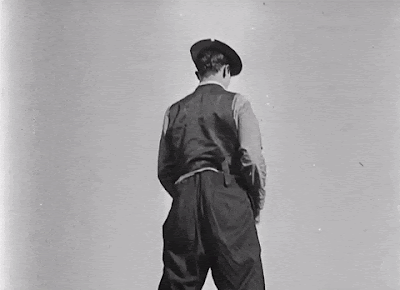 I just found this GIF online but I accidentally closed the tab before I could jot down where I found it. |
|
Remember above when I stated that Rohauer was likely telling the truth
about finding a print of The Boat in Buster’s garage?
This is why I say that.
Once upon a time, many moons ago, Bruce Lawton plopped in a VHS for me to see.
It was a poor copy of a kinescope from maybe 1960, and it contained the above clip from The Boat
but without any rotting!
Or at least with very little rotting.
I bet it was copied from the print in Buster’s garage, but I bet it was copied only to 16mm.
Anyway,
a better print was recently discovered!
I hope it will be used to create a superior edition someday.
|
|
Now we need to explore the data that derailed Jim Curtis’s investigation.
|
|
Let us turn to Jim Curtis’s book, Buster Keaton: A Filmmaker’s Life (NY: Knopf, 2022),
open it to page 745, and look at the lengthy note for page 612:
|
|
...In a 1976 interview with Keaton biographer Tom Dardis,
Harold Goodwin was asked about the films Keaton supposedly kept in his garage.
“What?” Goodwin responded. “Oh no, he didn’t have any of those.” Dardis: “Really?
No nitrate copies of The General, Cameraman, Navigator, The Three Ages, all the shorts?”
Goodwin: “No, none of that. He had a 16mm projector, so he might’ve rented some of
the old films from a camera store, but he didn’t own any.”
|
|
Let’s pause right there, because we need to explain a few things.
Yes, in those days, as we learned on the earlier page about
Revival Houses,
some camera stores did indeed carry a library of 16mm films for rent.
The shops purchased these from various catalogues —
the Kodascope Library, the Pathégram Catalogue, the Universal Show-at-Home Library, the Bell & Howell Filmo Library,
and probably a bunch of others, too.
As for Hal Goodwin denying that Buster had films in his garage, well,
that could mean one of two things.
Either it could mean that Buster had no films in his garage,
or it could mean that Hal was not aware that Buster had films in his garage.
Indeed, why on earth would Hal know if Buster had films in his garage?
If Buster had a projection booth in his house that was rated to contain film fires,
and if he pulled out the films to show to his friends during Sunday-evening dinners,
then, yes, Hal would have known.
But Buster had no facilities to run 35mm film.
He just had some old film in the garage, and he had it because he carried his old cutting copies
along with him wherever he moved, like any other trunk or crate of old belongings.
So why on earth would Hal know about film in Buster’s garage?
Do you know what your neighbors have in their garage?
Do you even know what you yourself have in your own garage?
We can take Hal’s statement either way.
Shall we continue with the endnote?
|
|
Edward Watz once asked Eleanor Keaton if Rohauer’s account of how he and Buster
took Keaton’s personal print of Three Ages to a lab to be copied was true. “She sort of
twinkled her eyes, smiled, and said, ‘Well, it makes a good story, doesn’t it?’
|
|
Let’s pause again.
We already encountered that passage, and, on its own, it seems quite authoritative.
Above, though, I expressed my doubts that Eleanor would ever have known about the episode.
After all, why would she have known about it?
She did not go along.
It was just a drive of a few minutes up the road and back.
She probably didn’t even notice that Buster was away for 30 minutes or so.
As I argued above, while this part of the story might be make-believe,
it fits perfectly with the rest of the known details.
Now let us continue with the third and final paragraph of that endnote,
which is the most difficult part of the endnote:
|
|
Rohauer promulgated many falsehoods concerning his relationship with Keaton, and
key among them was his assertion that he and Keaton met in 1954. “Rohauer slipped
once,” said Watz, who was employed by Rohauer for four years, “and told me that he
‘didn’t know Buster’ when The Buster Keaton Story was being made ‘or I would have
worked on Paramount to make safety copies of all his films.’ I didn’t point out the discrepancy
to him — Buster being busy on the production in 1956 and heavily promoting
it in 1957.”
|
|
That is a doozy of a statement.
Did Ray Rohauer really say such a thing?
If so, he was terribly confused.
As we shall soon discover, Ray Rohauer was involved in the production of The Buster Keaton Story,
and he was involved because Buster was involved.
It seems true that he did not “work on Paramount” to make preservation negatives of his silent films.
That was simply because Paramount did not need any such things and did not want any such things.
We’ll get to all that by and by, though.
|
|
Jim Curtis told the story of the first few times that Buster and Ray met.
Turn to pages 606 through 609.
His reconstruction of events I found perfectly convincing and I had no reason to doubt any of it.
Then I found some old news items, and then Olga sent me more, and then I found yet more,
and now I am not in any way convinced by Jim’s telling of the tale.
|
|
On an evening in 1958
,
Buster took Eleanor to a screening of The General, a
picture she had heard much about but
had never
seen. The showing was at
a small theater in Beverly Hills
known as the Coronet, the
|
Summer 1954. She probably saw it in 1949 at the Westwood Community Clubhouse. In Los Ángeles, not far from Beverly Hills. 272 seats, as far as I know. |
|
What Rohauer wanted to know that night was if Keaton had prints of
any of his pictures, but Buster had to tell him no. James Mason had transferred
all of his personal prints to the Academy. Did Keaton own the rights?
Rohauer pressed. No, he told him, Joe Schenck owned them....
|
This is a summary of a conversation, built entirely of indirect quotes.
It seems plausible, and yet when we turn to the endnotes to discover the source, there is nothing.
|
What Keaton gave Rohauer that night was a target. The mother lode of
Keaton properties was close at hand — the Academy of Motion Picture Arts
and Sciences was within walking distance of the Coronet. All Rohauer, an
inveterate film collector, needed was access to those prints, presumably all
pristine 35mm originals. An association with Keaton himself would confer
legitimacy, but it wouldn’t go far enough toward Rohauer’s eventual goal,
which was a degree of ownership.
|
In truth, Ray Rohauer had been aware since early 1956 that the films were with the Academy.
Yes, AMPAS filed its archival films at the Margaret Herrick Library in those days,
and that was less than a mile and a half down the street, about ten blocks depending on how you count the blocks,
at 333 South La Ciénega Boulevard.
|
|
We shall finish this confusing story at the bottom of the following chapter,
which concerns The Buster Keaton Story.
|
